DUCKING

HUNTING, GATHERING AND STORYTELLING IN THE EARLY MORNING HOURS


HUNTING, GATHERING AND STORYTELLING IN THE EARLY MORNING HOURS
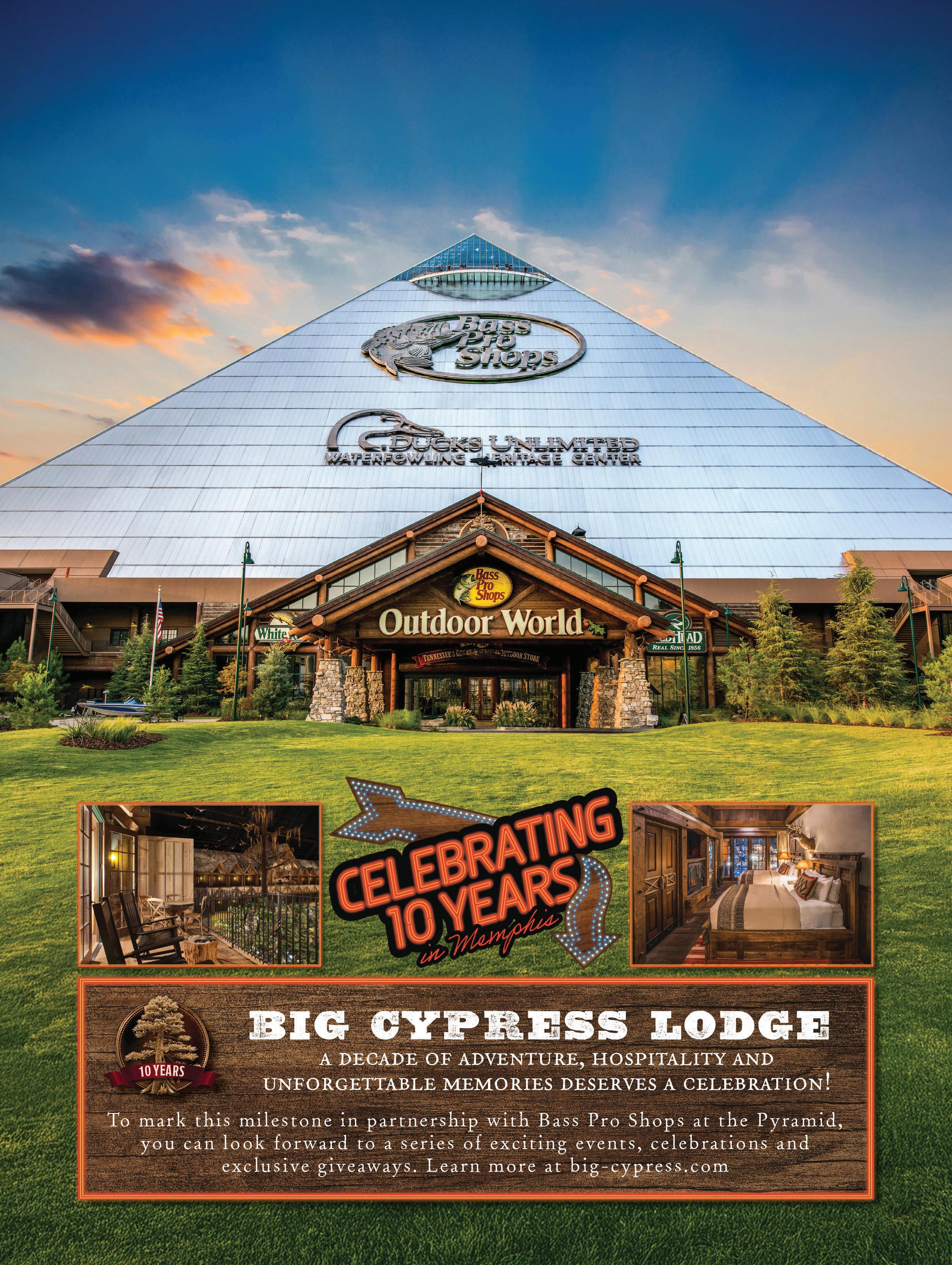









DUCKING AND WEAVING
Hunting, gathering, and storytelling in the early morning hours
HORMONE THERAPY MYTHS AND MISCONCEPTIONS
Dr. Franck
Mauvais-Jarvis on improving healthspan
According to Medicare reviews
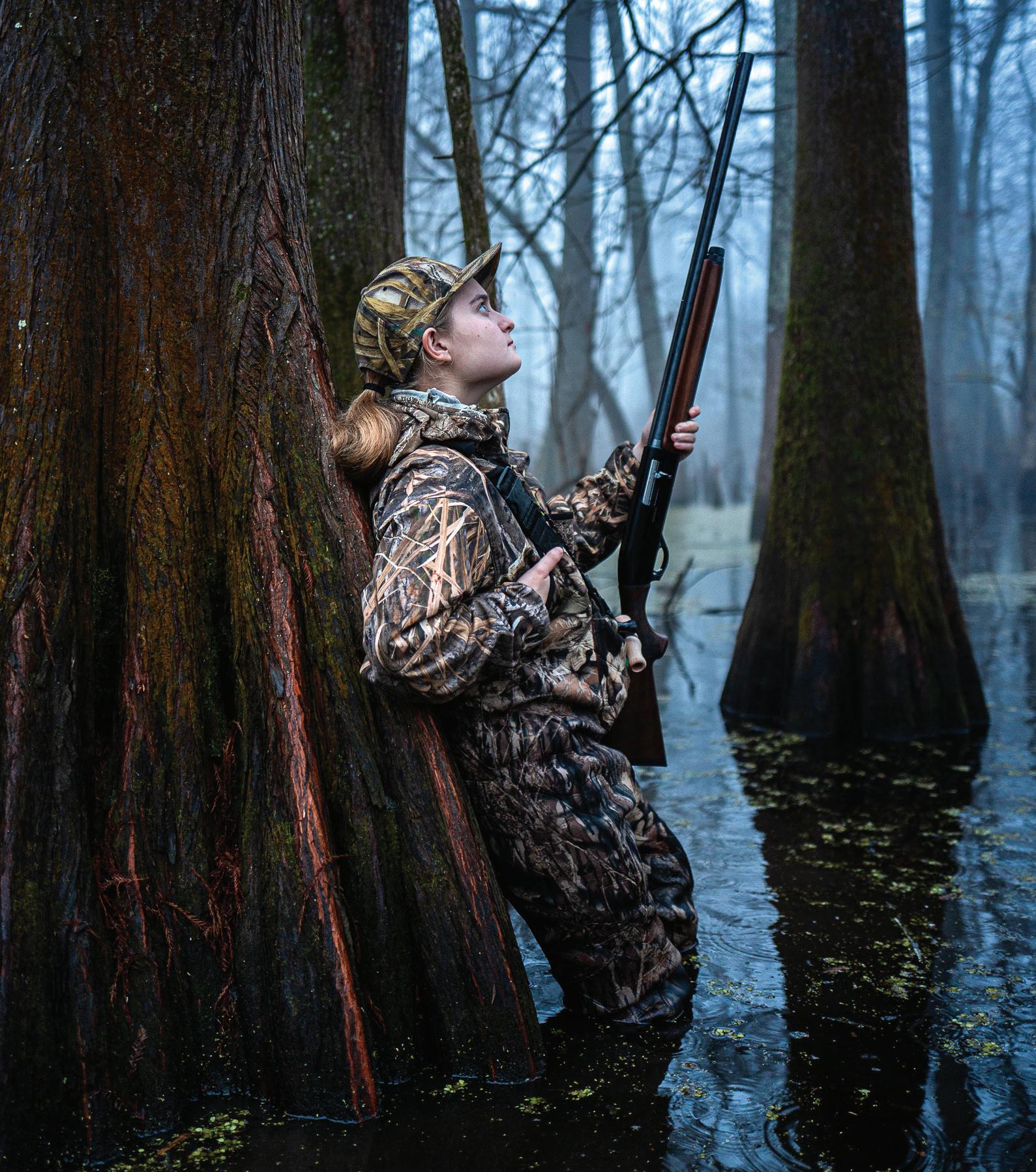



The infatuation, as so many do, began over a cup of coffee. Specifically, an oat milk latte made with precisely measured and pulled espresso using thoughtfully sourced and expertly roasted beans. Luma Coffee — housed in the circa-1890s historic Central Rexall Drugs in Hammond and one of downtown’s oldest buildings — is one of several delights I was surprised to find in the small city (albeit largest in Tangipahoa Parish). As I wandered around Hammond’s spectacularly preserved downtown with its boundless brick buildings and nearby movie set-worthy, historic Illinois Central Railroad train depot (a working Amtrak stop), I played the age-old “what would it be like to live here” game. Yes, I Googled housing prices and yes, there are some great deals.
of the secret, surreal and nostalgic

Marcella Simien and the zydeco blues
Howes
path from teacher to artist
goodness without the heat
spots galore for fishing and hiking —
LOUISIANA MADE
Carencro retiree creates guitars out of upcycled cigar boxes 1. Carencro p. 22 2. Ponchatoula p. 26 3. Natchitoches p. 30 4. Woodworth p. 54 5. Hammond p. 58

WELL, WE’RE RIGHT IN IT NOW. Summer and hurricane season, the double whammy. This can be a rough time for some people, both because of the unbearably long hot days and the memories of past hurricanes.
It’s hard to believe that 20 years have passed since Hurricane Katrina came. For some of us August can be an especially difficult month, and every time a new hurricane pops up on the radar, we tend to feel on edge. Jittery. At least, I know I do. Hurricanes Katrina in August 2005 and Rita in September 2005 were life-changing for many. And while I know being called resilient doesn’t necessarily make anyone feel better about that time in our lives, the experience for sure gives those who went through it a linchpin to situate their timeline. Shared experiences, shared trauma, shared stories, shared rebuilding or leaving — the time before Katrina and after.

My hope for this season is for a quiet, peaceful few months for everyone. Staying cool and doing all the things that bring joy are more important than ever. Self-care should always be a priority but perhaps even more so now.
Being gentle with the mind, body and spirit is central, and in this issue
Melanie Warner Spencer speaks with Dr. Franck Mauvais-Jarvis about the challenges older adults have with health and hormones. She dives into myths and misconceptions surrounding hormone replacement therapy and explores what people need to consider.
Another way to relax is to get out of town for a bit. Take a day trip or a road trip. In this issue, we explore what’s new and interesting in Hammond, an hour’s drive from New Orleans, and Beavers Bend, Oklahoma, less than a few hours from Shreveport. There’s nothing better than packing an ice chest with drinks and snacks, taking an overnight bag and hitting the road — especially getting on the highway before dawn and seeing the sun come up. Amazing. Whether it’s escaping for a bit of cool respite or just a change of scenery, a little adventure is always fun.
I hope everyone stays safe and cool this month. Take care!
Follow Us Subscribe
louisianalifemagazine
louisianalifemag
louisianalifemag
EDITORIAL
Editor Reine Dugas
Copy Editor Liz Clearman
Web Editor Kelly Massicot
Food Editor Liz Williams
Art Director Sarah E.G. Majeste
Lead Photographer Danley Romero
Food Photographer Eugenia Uhl
SALES
Sales Manager Rebecca Taylor 337-298-4424 / 337-235-7919 Ext. 7230
Rebecca@LouisianaLife.com
Renaissance Publishing
PRODUCTION
Digital Director Rosa Balaguer Arostegui
Senior Production Designer Ashley Pemberton
Production Designer Czarlyn Ria Trinidad
MARKETING
Marketing Manager Greer Stewart
Sponsored Content Coordinator
Jeremy Marshall
Visual Media Producer Mallary Wolfe
CIRCULATION
Distribution John Holzer
ADMINISTRATION
Office Manager Emily Ruiz
Chief Executive Officer Todd Matherne For Subscriptions Call 877-221-3512
Reine Dugas EDITOR REINE@LOUISIANALIFE.COM
Cool Off with a Hot Deal! Get 40% off a new subscription.
Must order online, new subscribers only expires August 31, 2025.
110 Veterans Blvd., Suite 123
Metairie, LA 70005
504-828-1380
128 Demanade, Suite 104
Lafayette, LA 70503 337-235-7919 ext 7230
LouisianaLife.com

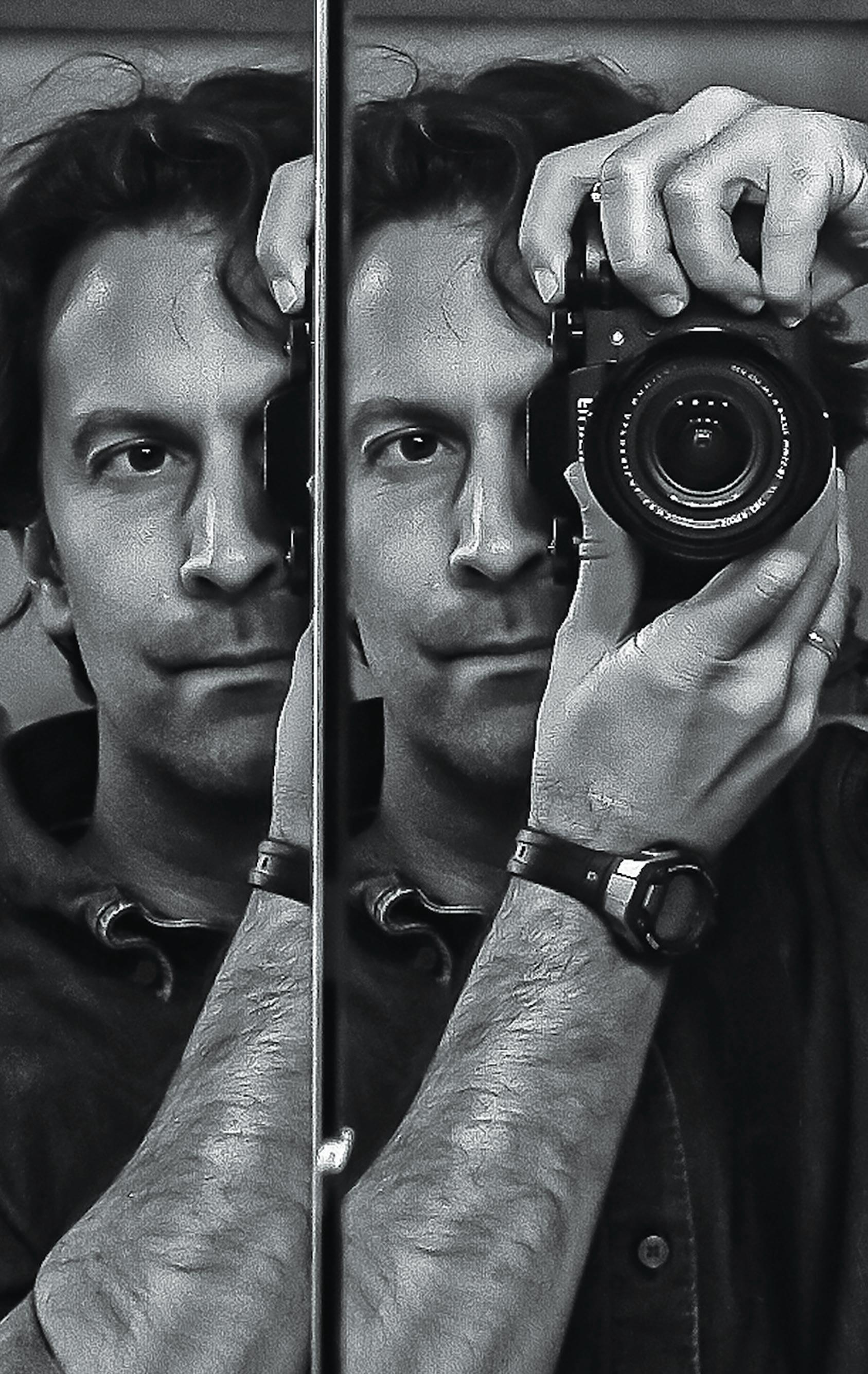
Kevin Rabalais, an Avoyelles Parish native, writes and photographs the Natural State series for Louisiana Life. His work has appeared in The Los Angeles Review of Books, The Australian, the New Zealand Listener, and the Argentine magazine Revista Ñ. He teaches in the Department of English at Loyola University New Orleans.

Kevin Rabalais “Tomorrow, and Tomorrow, and Tomorrow” by Gabrielle Zevin. It’s a page-turning pleasure about friendship and the creative process. I’ve never had so many people come up to me while I’m reading to say how much they, too, enjoyed a book.

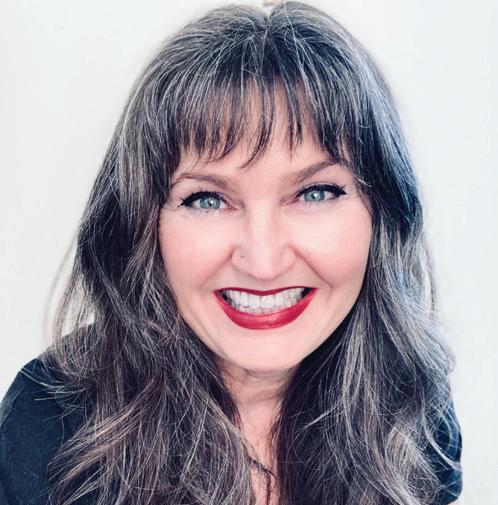
Melanie Warner Spencer an award-winning journalist, editor and photographer whose work has appeared in publications, including Reuters, throughout the United States and around the globe. Spencer has been a staff features reporter and columnist at The Austin AmericanStatesman, a senior reporter at The Houston Chronicle and also served as editor of New Orleans Bride, New Orleans Homes, Acadiana Profile and Louisiana Life magazines. In her spare time, Spencer is a private yoga teacher and Ayurvedic nutrition counselor, cat mom and member of The Merry Antoinettes Mardi Gras marching krewe in New Orleans.

Liz Williams Hugh Acheson’s “The Broad Fork.” It is a cookbook full of ways to approach the ordinary vegetables I already eat, as well as a guide to vegetables, which I should be eating but am not.
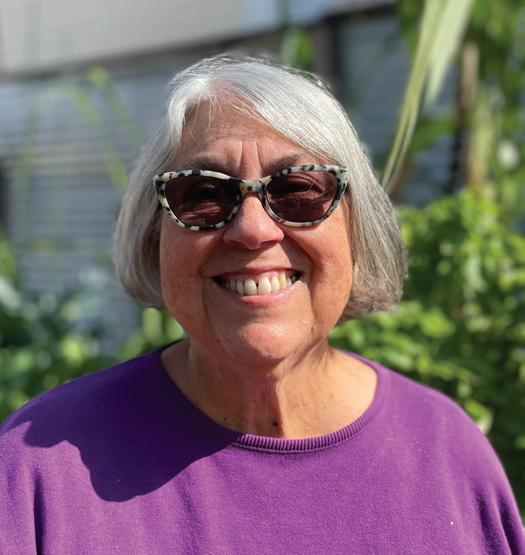
Liz Williams founded the Southern Food & Beverage Museum and authored several books about food and culture, especially New Orleans food culture. Her podcast, Tip of the Tongue, about food, drink and culture, appears weekly. She is a graduate of LSU Law Center and has practiced law in Washington, DC and Louisiana. She has served as judge in many cooking competitions and consulted internationally on the food of New Orleans. Travel is an excuse to eat in new places.



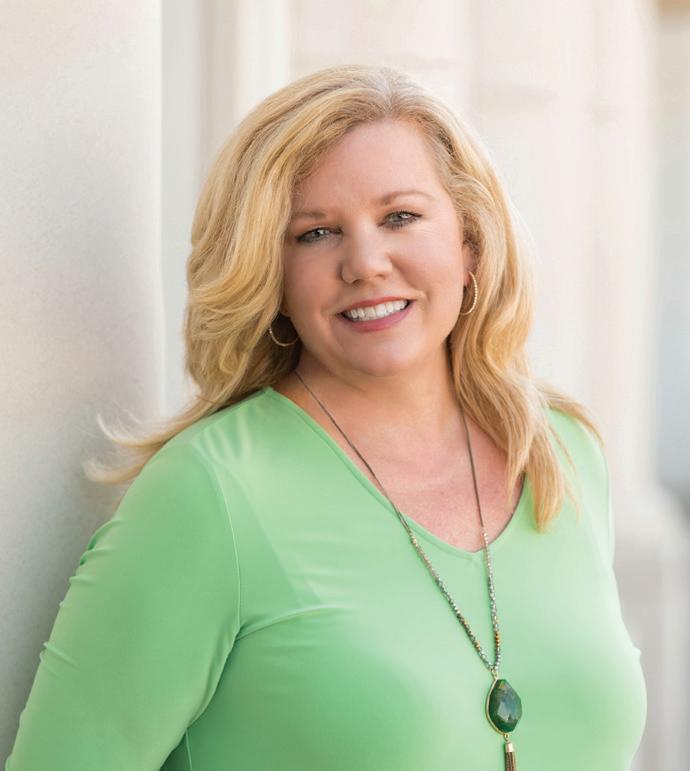

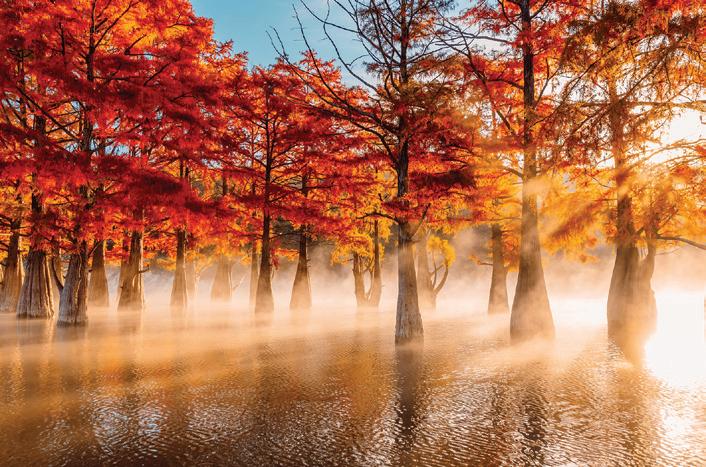

BY LISA LEBLANC-BERRY
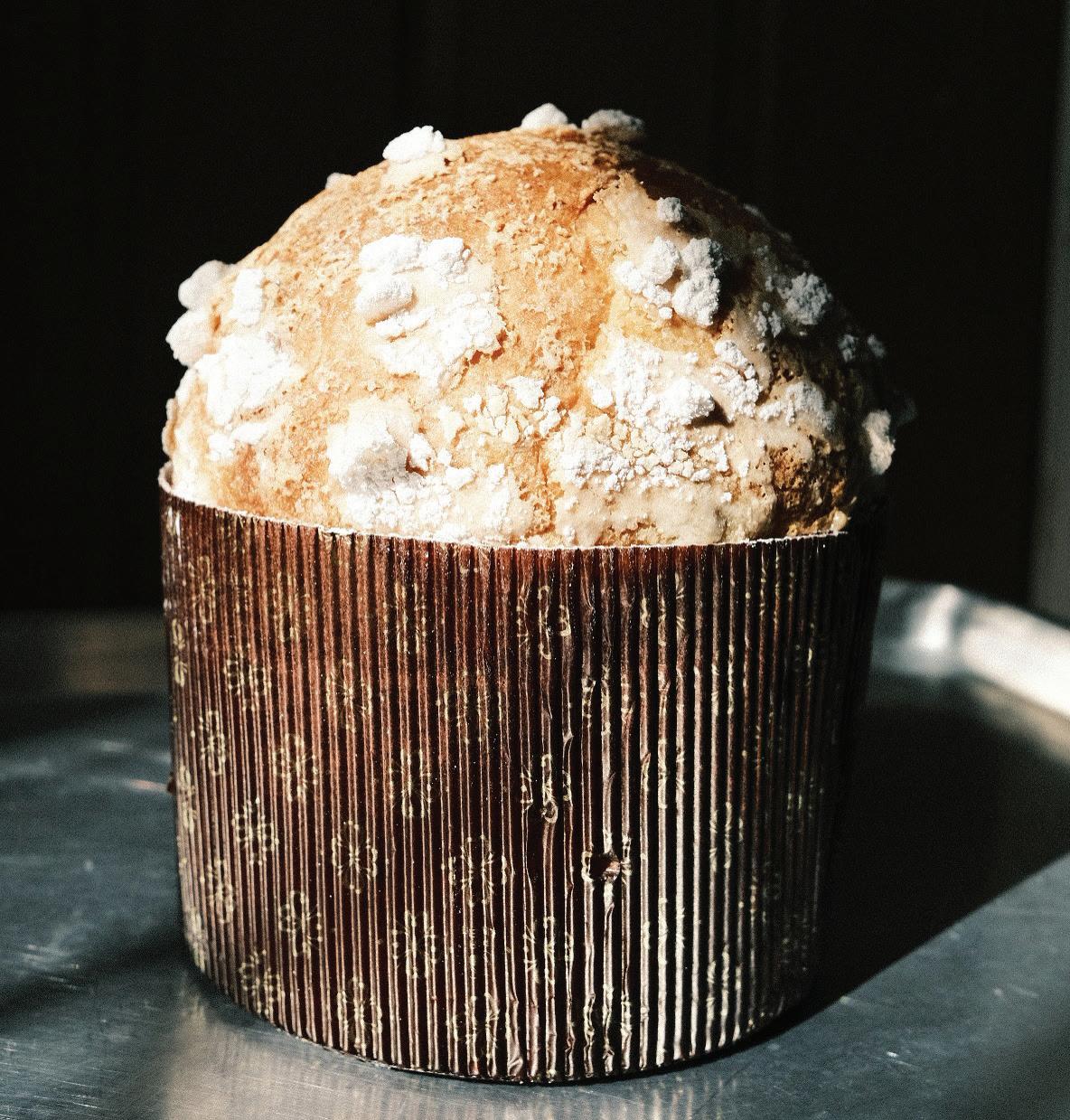
The whisper of Michelin Guide’s undercover inspectors finally turning their gaze toward Louisiana has ignited a firestorm of finesse and competitive swagger. Among the profusion of notable new contenders in New Orleans: Le Moyne Bistro is luring Francophiles to the Warehouse District with French wines, cognac-tinged onion soup lavished with Gruyere, steak tartare and lavender-scented crème brûlée (formerly Tommy’s Cuisine, adjoined to new sister eatery Maria’s Oyster & Wine Bar). Uptown, on flourishing Freret Street, fashionable foodies frequent The Husky for a high-energy mountain lodge vibe, ritzy entrance bar, mouthwatering lamb lollipops and beef Wellington (from the same team behind the nautically themed Pigeon & Whale across the street). You won’t find signage outside the stylish Avegno (1726 Soniat St.) that was originally intended as a new “dining bar” flanking Gautreau’s. Instead, it has ascended among the cognoscenti as a chic destination for Gallic fare and stellar wines-by-the-glass, fresh oysters and fondue (from Gautreau’s acclaimed kitchen). The revered team behind popular Uptown restaurants Osteria Lupo and Costera opened Brutto Americano (formerly Josephine Estelle) in The Barnett featuring modern Italian cuisine in a stunning Art Deco space downtown. The Marigny’s cozy Evviva (formerly The Franklin) boasts James Beard award-winning Chef Rebecca Wilcomb and an ever-changing Mediterranean menu. Katilin Guerin’s bustling Central City Lagniappe Bakehouse (New Orleans’ only James Beard Award finalist in 2025) has a cult following for sweet and savory baked goods elevated with West African spices.
Natchitoches is adding something extra to the festive fireworks show on Independence Day weekend (July 4-5). Hot air balloons are soaring over the Cane River during the Natchitoches Balloon Festival in celebration of America’s birthday. Dusk brings a mesmerizing balloon glow illuminating the sky. Visitors can meet the pilots, take a balloon ride and enjoy live music and the reimagined fireworks.

The city of Lake Charles launches a celebration of America’s 250th anniversary of the signing of the Declaration of Independence with Red, White, Blue & You! (July 4). It’s the first event of a year-long celebration featuring a patriotic concert, an Armed Forces salute and a fireworks extravaganza over the lake.
Country crooner Joe Nichols (“Brokenheartsville,” “Sunny and 75”) debuts as the headliner for the 73rd annual Delcambre Shrimp Festival (August 13-17) featuring a fais-do-do, five-day street fair, local bands and Blessing of the Fleet. Morgan City celebrates the 90th annual Louisiana Shrimp and Petroleum Festival (August 28-September 1) with more than 100 venders offering new arts and crafts, a Children’s Village, carnival, children’s parade, oil rig tour and novel fireworks show.
Oenophiles and foodies are descending on Baton Rouge to sample an international array of more than 200 wines paired with culinary creations from a novel selection of top chefs during the 18th annual Fête Rouge (August 22).The gourmet weekend is enlivened with entertaining chef competitions.

BY CHRISTOPHER LOUIS ROMAGUERA

Teresa Tumminello Brader’s second book, “Secret Keepers,” is a collection of short stories. The stories are steeped in characters who are struggling in their relationships with loved ones and the world around them. We deal with characters worried about their partner possibly having an affair, but also a story that follows families who are struggling to rebuild among the onslaught of hurricanes. The stories are filled with people and a New Orleans that will seem familiar to any local reader, as Tumminello Brader uses her lived-in experience to capture her hometown. We feel this experience in how she writes about hurricanes, but also how she captures local neighborhood bars such as the Parkway Bakery & Tavern. 160 pages, $17.95

“Midnight Self” is Adrian Van Young’s second collection of short stories. Here, Van Young writes short stories that are equal parts surreal, horrifying and human. He takes the reader into different worlds with each story, but one feels more emotionally impactful than the next. In the short story, “The Man Who Wore Death,” we see all of Van Young’s writing strengths. The story, despite its title, starts with the line, “There once was a man who wore high khaki pants,” which makes it hard to not smirk. But Van Young writes a story about Death’s emissary and makes it human, personal, as every name on the planet is on the soon-to-be-dead list. Van Young is a professional freelance editor in New Orleans, where he lives with his family. 234 pages, $21.95

Arm Fixed to a Wing:
“An Arm Fixed to a Wing: Poems” is the second book of poems by writer, Olivia Clare Friedman (published by LSU Press). The book mixes the joy and complexity of motherhood with themes of nostalgia and mixes free verse with poetic forms like the elegy. Friedman finds the spiritual in our physical and shared world, such as in her poem titled “Elegy for Gone Sounds,” which starts with the lines “Turn off all music. If I can’t have / sounds I remember—my father / coming home.” These poems capture not just the physical world, but the absences that hover over us, as we continue to try to hold on to our love. 72 pages, $19.95

Carolyn Nur Wistrand’s play, “She Danced with a Redfish,” was published by UL Press. The play follows the famous voodoo practitioner, Marie Laveau, as she navigates the world of the French Quarter and the spiritual practices that happen in New Orleans. This play finds a way to capture Laveau in a new and fascinating light. In this play, we see ghosts, spiritual practices and the landmarks in the city of New Orleans such as the Vieux Carre and Congo Square. Wistrand is a professor at Dillard University. 126 pages, $19.95
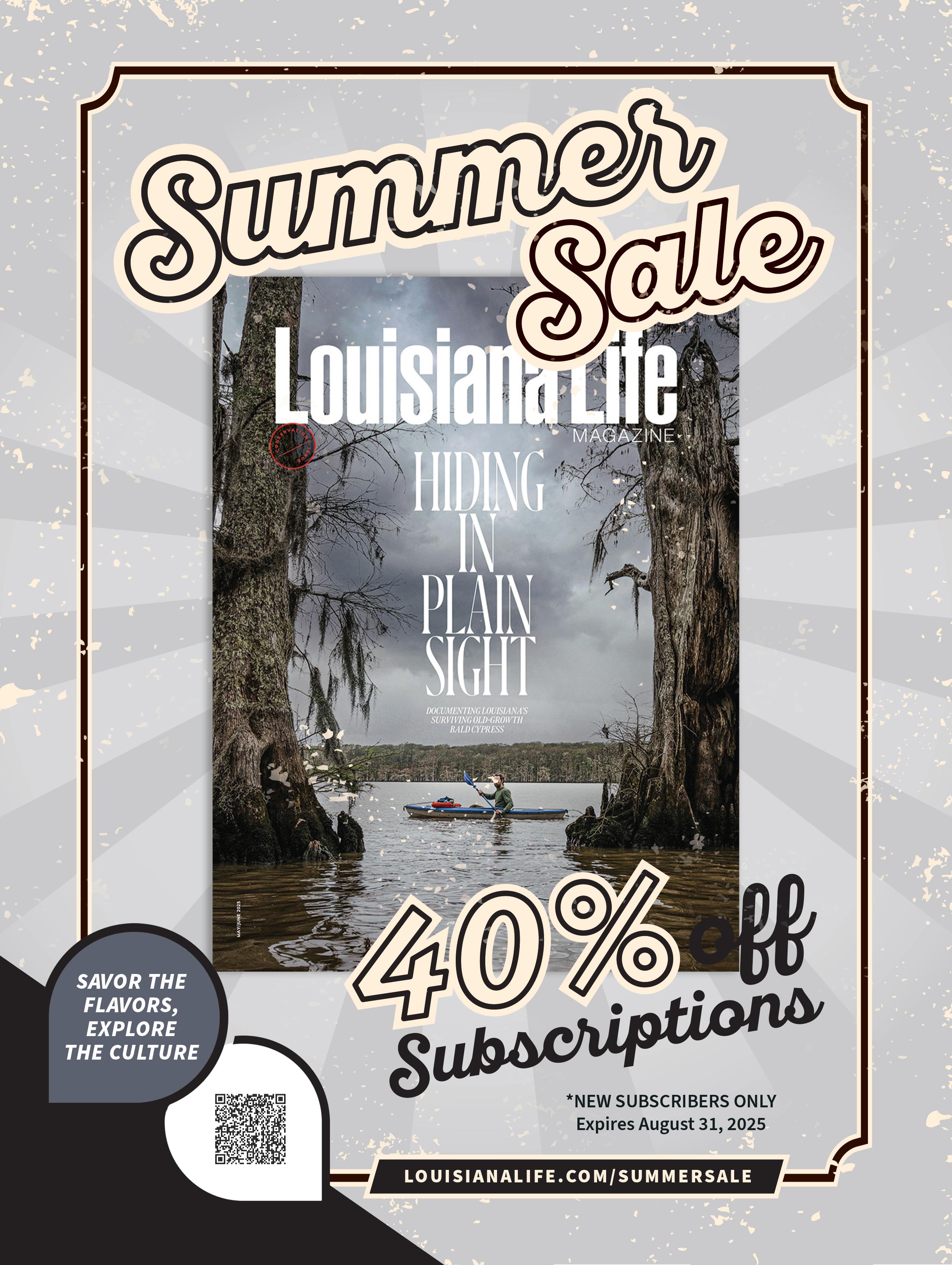
BY JEREMY MARSHALL

This randomized color vinyl record is uniquely its own color. You can purchase one at marcellasimien.com.
EPITOMIZING A MARRIAGE between zydeco and blues that embodies generations of an authentic musical tradition, Marcella Simien proudly takes her place as a standard bearer of the Creole sound through spiritual reinvention and modern innovation. Daughter of zydeco legend Terrance Simien, Marcella’s recent performances at the Jazz Fest, alongside the release of her first solo album “To Bend to the Will of a Dream That’s Being Fulfilled,” are a culmination of a lifetime spent seeking, dreaming and singing the soul of her heritage.
“The first song on the album, ‘Bloodline,’ is directly tapped into the wavelength of the past, ancestral trust and an inner wisdom,” says Marcella. “From an early age, I was witnessing my dad captivate audiences, and although I was maybe too young to know exactly what was going on, I knew what was going on. A profound inner knowing.”
“To Bend to the Will of a Dream That’s Being Fulfilled” is atmospheric and introspective, as much about Marcella as her family history. The third track on the album, ‘Leila’, celebrates Marcella’s Creole roots through the spirit of her great-grandmother, a hardworking woman who raised 15 children, made her own soap and lived entirely off the land. Though she had never met her, Marcella is able to conjure the feeling of her ancestor through a musical meditation that transcends
the bounds of time and space. There is magic in the passing of love through generations, and perhaps no form is better suited for spiritual transference than the interweaving of blues and zydeco, of music born from the spirits of hardworking people with callouses on their hands and love in their hearts. It is this legacy, above all others, to which Marcella is most indebted.
“Amédé Ardoin was sent from God to give us early Creole music. In my opinion, the seeds he planted are where zydeco sprouted from — same goes for Canray Fontenot and Alphonse “Bois Sec” Ardoin,” says Marcella.
“The soul of zydeco to me is Louisiana’s Creole people, Creole culture, the smell of a sauce piquant in papaw’s kitchen, the spirit of people who want to feel free and have a good time in community with one another.”
With performance dates running through fall 2025, Marcella is ready to connect to new audiences. There is something ethereal in Marcella’s voice, harmonizing alongside the traditional whine of the accordion and the soft percussions that remind the ear of simple acoustics played upon the bark of ancient cypress trees and lit by the flicker of fireflies. If the sound of Louisiana is the wail of zydeco, Marcella Simien is doing her part to spread its good word through a voice that is uniquely her own yet carries with it the profound weight of legacy.

Hidden Louisiana
Discover places and things that are off the beaten path and mostly known by locals
Fall Fun Travel
Our favorite places to go for festivals, food and other fall fun
Farther Flung: Arkansas
Reserve space August 4
Food Lovers Travel Guide
Hit the road for foodie adventures you’ll never forget
Top Doctors
A listing of the state’s top doctors, nominated by their peers in a survey process by Castle and Connolly Medical LTD
Farther Flung: Mississippi
Reserve space October 3
CONTACT
Rebecca Taylor
Rebecca@LouisianaLife.com
337-298-4424

Carencro retiree creates guitars out of upcycled cigar boxes
BY JEFFREY ROEDEL

CAJUNS AND FRANCOPHILES in Acadiana might see “BCBG” and take it as short-hand for the French catchphrase “bon chic bon genre” (“Good style, good class”). Anyone with a Ramones shirt or Blondie bob might read it quick and see an anagram for CBGB, the infamous New York City club that gave rise to those icons and a string of other hit bands in the 1970s. Neither misconception would be too wayward of an allusion to its true meaning, though.
In the hands — and drill and jigsaw — of Gerard Guidoni, BCBG is Bayou Cigar Box Guitars, the upstate New York native-turned Carencro retiree’s brand of carefully crafted homemade instruments.
“This isn’t a business really, it is a hobby that got out of control,” Guidoni says with a chuckle. “They started taking over the house, and that’s when I knew I had to start getting rid of them.”
After a decades-long career editing legal texts for Reuters and The New York Times, Guidoni, now 62, retired, and his wife, Sandra moved to New Orleans in 2017. They’d spent years escaping New York’s bitter winters and vacationing in the Big Easy. Finally, the food, the music and the friends they made pulled them to Louisiana permanently.
Eventually migrating just north of Lafayette, Guidoni drew on years of inspiring performances at blues festivals and the region’s love of stringed instruments, and he began making his own guitars.
“It’s a fun process, and I have the time to do it,” says the creative who sifts through outcast boxes at local cigar shops, with their gilded inlays and vivid colors, and he often buys them in bulk. “I want to keep them as simple as possible, as a throwback to what cigar box guitars originally were. I want them to look and sound
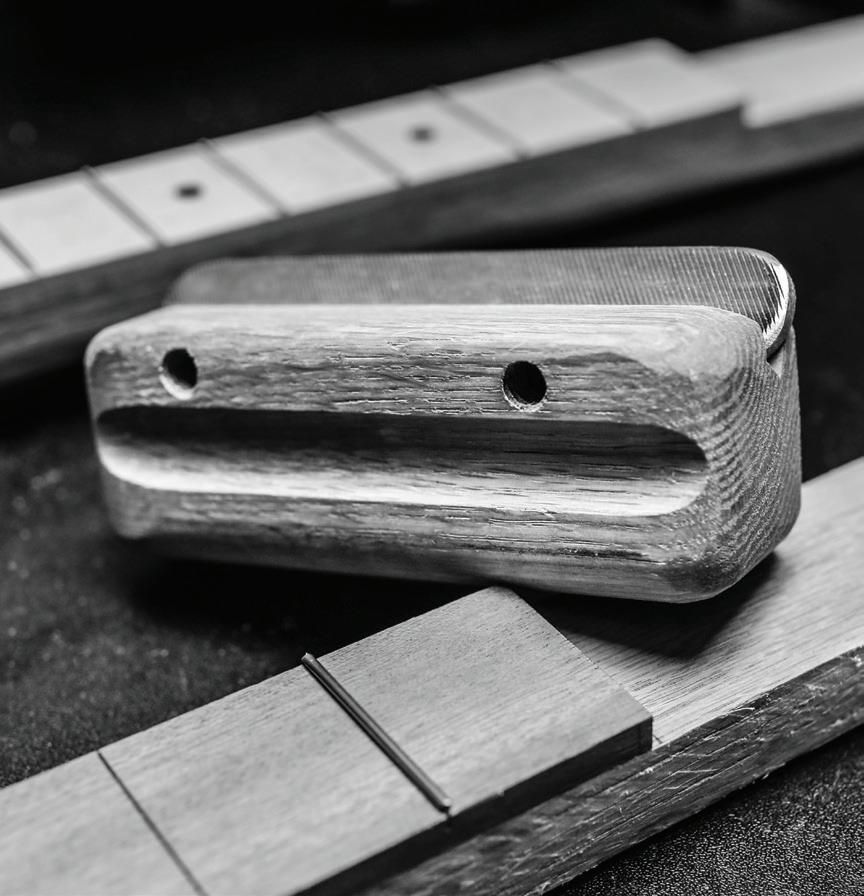
good, of course, but beyond that, I don’t want to fancy them up too much.”
Unlike Fender or Gibson, classic guitar brands with signature sounds, each cigar box guitar is not only handmade, it is fashioned from upcycled boxes that can have a variety of differences and feature an array of eclectic guitar parts. The result is a tone and resonance that can sound as unrecognizably unique and curious as its player’s personality.
Three strings and a whole lot of noise, they are the definition of indie. A humble instrument and a reminder to make the best of what you’ve got, for generations, the guitars made out of cigar boxes and wood planks as sonic weapons of necessity, proliferated by the grit and ingenuity of players who could not afford the polished mass-produced store-bought instruments.
They are, in their own way, pieces of folk art.
“I appreciate that Gerard is keeping this tradition going,” says Jeannie Luckett, program director at the West Baton Rouge Museum, where Guidoni recently participated in the annual SugarFest. “His instruments are beautifully made and affordable and each has its own personality. Having Gerard set up near the stage where Kenny Neal and Lil Ray Neal were playing, festivalgoers could see how these instruments are made and hold them in their hands, and that just really added another layer of enrichment and interaction for our event.”
From Bo Diddley and Louisiana native Buddy Guy, to Jimi Hendrix, Jack White and Samantha Fish, there is always a titan of the blues or rock that is creatively sustaining the tradition of this humble instrument.
Now Guidoni is working on his first cigar box basses, and guitars for players with smaller hands, like children. But his only true goal for passion project is to keep enjoying it and let the music play on.
“I started playing harmonica and guitar because it was fun, not because I was an expert at it,” Guidoni says. “I think that’s a big part of what I’m doing making cigar
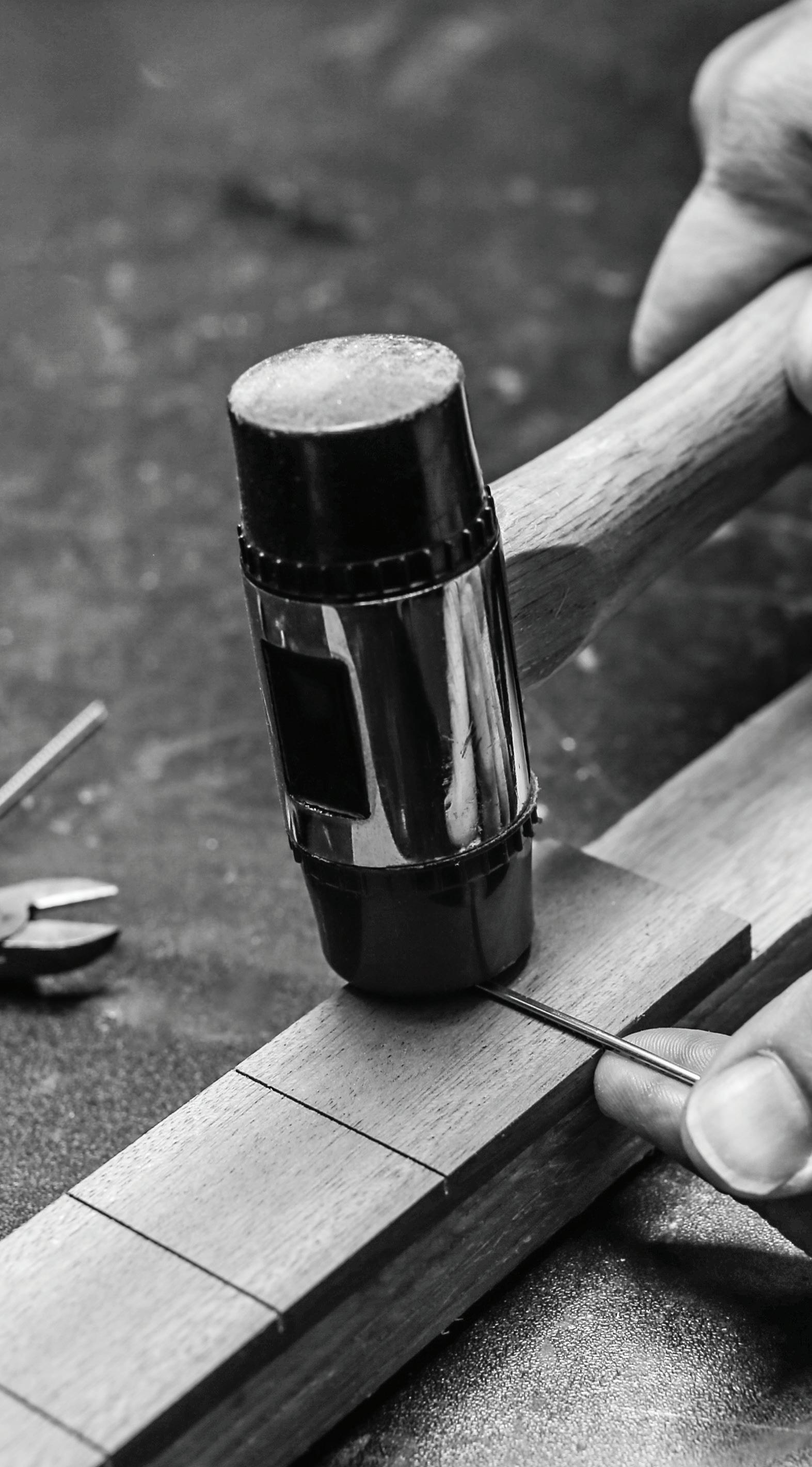
box guitars. I think it should just be fun for people and super easy to pick up.”
BCBG can be found at a handful of Louisiana festivals each year, and on Facebook.
“I’d love it if at the next festival someone came up and said, ‘I bought one of your guitars, took it apart, changed some things, added this and that, and made my own,’” Guidoni says. “It’s about encouraging people to get involved, to make whatever music they want to make and to make their own instruments. That’s all I want.”


If you could make a cigar box guitar for anyone famous, who would it be? Samantha Fish. I think just about every cigar box guitar builder has gifted her one, but she only plays her original.
What type of wood do you use for your necks? The necks are either oak or poplar. Poplar is easier to work with. Oak can take more wear and tear. I try to use repurposed objects as much as possible — nuts and bolts for bridges and, hinges for tailpieces, candle cups for the sound hole trim. And, of course the boxes themselves.
I bet you’re friends now with all the cigar store guys. How does that go? They’re usually pretty happy to see me take boxes off their hands. They’re just a pile of junk to them. The guys at Bailey’s Cigar Room in Carencro are great. They’re really into the cigar box guitar thing and are very supportive. They’re planning a cigar box guitar festival here in Lafayette in September in conjunction with Wildcat Brothers Distilling.
BY JOHN R. KEMP
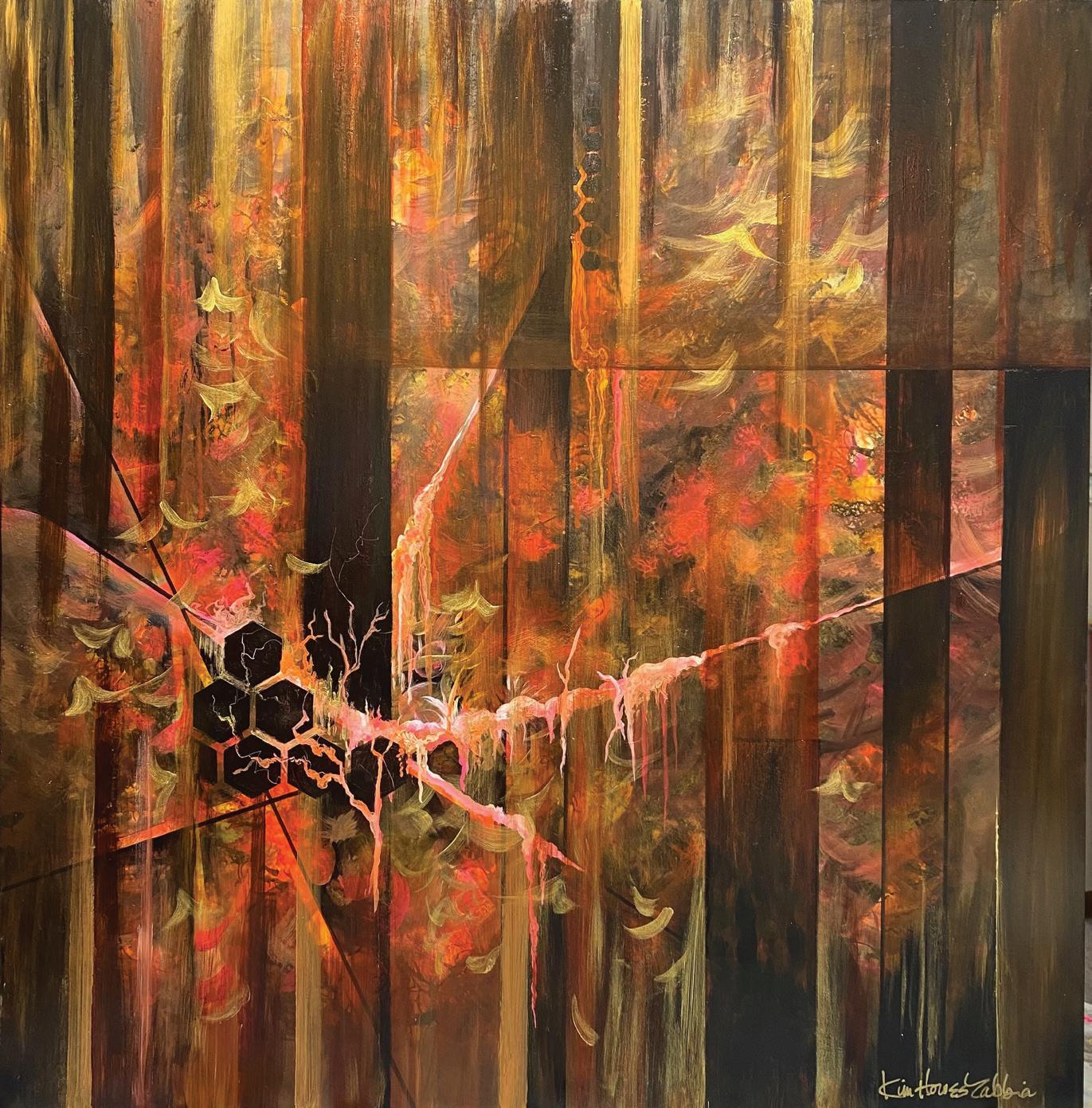
(Above) Enchant
(Facing page, top)
Channeling (Left)
Silhouette (Right)
ART, TO PONCHATOULA ARTIST, teacher and writer
Kim Howes Zabbia, is about freedom, control, creativity, fear. Her paintings and sculptures express the intuitive exploration of her own subconscious as it responds to her surroundings and to the rural Louisiana landscape.
Born in 1952, the Ponchatoula native has enjoyed a long and successful career as an artist, teacher and writer. It is a career that began as a child with a mother who taught her how to draw what she could see and a father who taught her how to create what she could not see. “He taught me creativity,” she says, “and Mom taught me the technical end.”
To an observer, Zabbia’s life as a teacher, writer and artist seem inseparable. With degrees in English, journalism and art from Southeastern Louisiana University and a master’s in fine arts from LSU, Zabbia taught art at Ponchatoula High School for 32 years before retiring in 2007. The next day she opened The Art Station in Ponchatoula as an art school for adults. Fifteen years later she sold the school and began teaching art part-time at Ponchatoula’s Twin Steeples Creative Arts Center.
“I couldn’t imagine not teaching,” says Zabbia, who is married to Ponchatoula’s long-time former mayor Bob Zabbia. “We mostly do critique sessions at the art center. But what I love most is networking artists, being able to connect artists and helping them with their careers. I did a talk called ‘It’s not bad art, it’s bad marketing.’ Visual artists are not competitive. They are so willing to share ideas that they have. It’s a great community to be a part of.”
Teaching artists how to market their work is one of several underlying themes in her book “Just Paint, It Ain’t.”
“Artists have to realize that their job is a jungle gym, it’s not a ladder,” she says. “They are not climbing up a ladder and at the top is a gallery to take care of them. They have to understand that they make a career out of being an artist by creating a product but also by doing a workshop, also doing a market, taking commissions, doing merchandise and marketing the product.”
Zabbia’s first book, “Painted Diaries,” published in 1996, is an emotionally moving story that explores through paintings her mother’s journey into Alzheimer’s disease. Even the paintings in this book are subconscious responses to her mother’s condition.
“Everything comes from the subconscious,” she says. “It comes from 73 years living in this atmosphere. I’ve often told artists that if you plan a painting, you are opening yourself up to disaster before you even begin. It’s better to not think that much. Just move right into it and let the paint do its job. I never paint what I’m looking at. I can paint what I see, but the key to my painting is that I leave myself completely open to whatever the paint shows me.”
Like most artists, Zabbia titles her paintings, but they are never direct descriptions of the subject matter. She wants viewers to think about the imagery.


“That’s why the titles are never obvious,” she says. “There are three ways to title a painting. You can title it exactly what it is, you can title the method you use or you can give it a title that makes the viewer think. I like that third method. So, I stick with adjectives, verbs or vague nouns that will make them think. They give you a hint of what the artist had in mind, but I’d rather they put their own feelings into the painting instead of trying to figure out what mine were.”
As to her painting style, Zabbia says her work most resembles Surrealism, that post-World War I avantgarde art movement that unleashed the subconscious and championed artists such as Salvador Dalí.
“The Surrealists are my favorite,” says Zabbia, who paints mostly in her studio rather than on location. “They all have hidden images in them. That makes people stay and look at them longer and longer.”
When asked how she feels when painting, she laughs slightly and says: “Frustrated, ticked off, angry and finally when I’m ready to throw it in the trash, I

go, ‘Oh, it’s a masterpiece.’ My biggest problem is that I keep working on it. Paintings are never finished, they just stop in interesting places, so Picasso said. I sometimes work them to death.”
Though she may get “frustrated” or “ticked off,” Zabbia says she must paint and sculpt. “You just have to do it,” she says. “You have to create something. Once you get into it, you realize how therapeutic it is. It helps you become less judgmental or critical of other people.”
Through it all, there are constant underlying forces that drive her work.
“It is about freedom versus control, creativity versus fear,” she says, “You want to be as free and as creative as you can be.”
For more information, visit kimhoweszabbia.com.
CAJUN
Tides, Time, and Terrain: Floyd Sonnier and the Evolving Cultural Landscape. Sonnier’s timeless imagery of life in Acadiana paired with other notable South Louisiana artists, through Aug. 1. Hilliard Art Museum, Lafayette. hilliardmuseum.org
CENTRAL Enduring Concepts: People, Place, Spirituality, and Emotion.
Exploration of the museum’s permanent collection, ongoing. Alexandria Museum of Art. themuseum.org
NOLA
Afropolitan: Contemporary African Arts. NOMA’s collection of pioneering African Artists of the 20th and 21 centuries, through Dec. 28. New Orleans Museum of Art. noma.org
NORTH American Cowboy: Alternative Landscapes. Legendary Western figure in abstract landscapes, through Aug. 1. Masur Museum of Art, Monroe. masurmuseum.org
PLANTATION
In Focus: Artwork by LSU Faculty. Visual arts by LSU School of Art professors, through Aug. 3. LSU Museum of Art, Baton Rouge. lsumoa.org
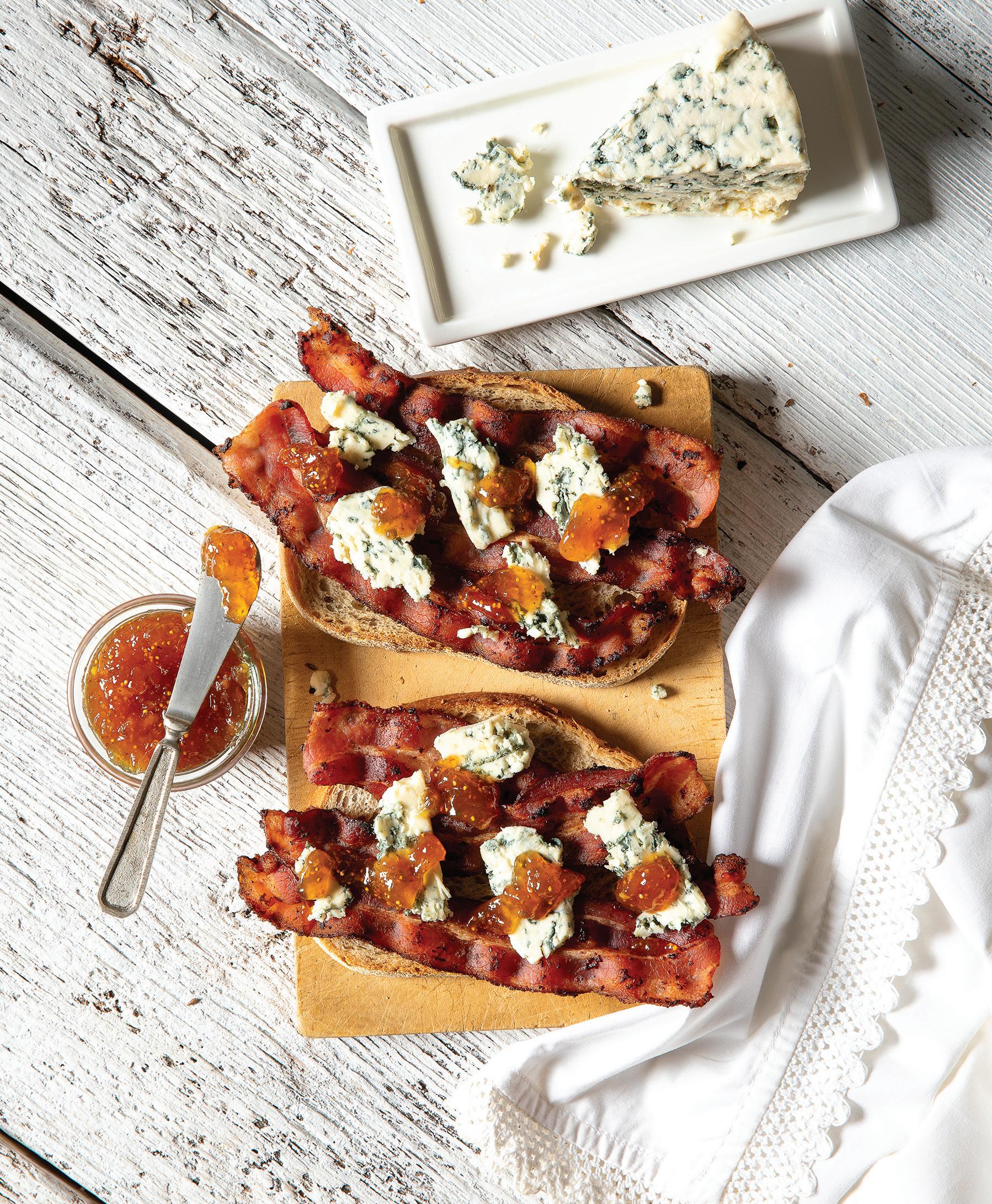
All the goodness without the heat
BY LIZ WILLIAMS PHOTOS AND STYLING BY EUGENIA UHL
IT’S HOT. There is no getting around it. So if you are water skiing or hanging around a swimming pool or out fishing, you probably want to have delicious meals without heating up the house. That means that it is the wrong time of year to bake a ham or turkey. But this is also the time of year when produce is bursting with flavor, and taking advantage of that is just as important as fishing. Try making tomato soup with warm tomatoes fresh from the garden. It can be quick and painless, while still tasting really sharp and sweet. That is one of the best things about summer. It brings out the sweetness and the special mineral-y flavors of the tomato. Try our recipe with a grilled cheese sandwich made with your favorite cheese and great bread.
You will eat this fig jam so quickly that there is no need to can it. But don’t leave the jam on your cupboard shelf. Keep it in the fridge. I personally love fig jam on cornbread. And it makes a special openfaced sandwich — your favorite bread spread with soft blue cheese, bacon and fig jam. Yum!
2 pounds figs, stemmed and chopped 1 ½ cups sugar Generous ¼ cup of lemon juice
1. PLACE the figs in a stainless steel or enameled pot. Stir the sugar into the figs and make sure that the figs are well coated. Allow to sit for 30 minutes to allow the sugar to force the figs to release liquid.
2. ADD the lemon juice and ½ cup of water. Place over a low burner and stir. Cook about 20 to 30 minutes, stirring occasionally. Spoon into 3 8-ounce jars. Cover and keep in the refrigerator.
Be ready for pancakes or French toast with orange syrup that you can make, pop it into the refrigerator, and it is ready for a Louisiana-flavored breakfast. If you are up for it, make beignets and drizzle this syrup over the hot dough just as it comes from the pot. With a cup of coffee you will be quite happy to face the day.
Spicy pecans are ready for you anytime you need a snack. They are good with drinks or chopped on a salad. They are easy to make. And they take advantage of an abundance of pecans. Getting Louisiana pecans that haven’t traveled very far is the best.
Twice-cooked sweet potatoes uses yet another local product. You can bake the sweet potatoes ahead of time and refrigerate them for up to three days before making twice-cooked sweet potatoes. You can cook twice as many sweet potatoes as you may need for a meal, and use half immediately and the other half to make the twice-cooked ones. For dinner you could pair the sweet potatoes with the tomato soup and add a salad.
Louisiana is so rich in exciting things to do during the summer, even though it is indisputably hot, and it is so rich in delectable home-grown foods, there is nothing better than combining those things and making the most of summer. If you are hot, eat a slice of chilled watermelon to rehydrate and savor the sweetness, the crispness and slightly acidic freshness. Go ahead, eat another one, and maybe have a watermelon seed spitting contest while you are at it.

1 teaspoon sea salt or your favorite finishing salt
1 teaspoon cayenne
1 teaspoon granulated sugar
2 pounds pecan halves
2 tablespoons olive oil
1. PREHEAT oven to 350 F and line a baking sheet with parchment paper.
2. MIX salt, cayenne and sugar in a small jar. Cover and shake to mix thoroughly.
3. PLACE nuts into a bowl and coat with oil. When all of the nuts are oily and shiny, sprinkle with spice mix and stir well to coat.
4. PLACE about half of the nuts on the baking sheet and spread the nuts into 1 layer. Place into the prepared oven and cook for 7 minutes. Stir well, making sure that the nuts are again in a single layer. Place back into the oven for another 7 minutes.
5. REMOVE the nuts from the baking sheet onto a tray and allow them to cool completely. While the first batch is cooling, cook the second batch. Repeat the instructions and cool the second pan.
6. WHEN COMPLETELY COOL , store in an airtight can or jar.
1 cup cane syrup
Peel from 2 oranges, cut into strips
1 2-inch piece cinnamon
PLACE all of the ingredients into a pot and bring to a simmer with ½ cup of water. Cook together until the syrup begins to boil. Remove from the stove and allow to cool. Remove the cinnamon stick. Store in a jar with the orange slices in the refrigerator.
Use as a sweetener for tea, syrup for pancakes or to top vanilla ice cream. And it is a magical surprise instead of sugar in bread pudding.
4 medium-sized sweet potatoes
1 tablespoon olive oil
4 ounces plain chevre at room temperature
½ teaspoon salt
¼ teaspoon black pepper
Freshly ground black pepper for garnish
1. PREHEAT oven to 400 F.
2. CUT 4 sheets of aluminum foil. Cut each sweet potato in half lengthwise. Keep each potato together.
3. WITH A BRUSH , spread oil over all of the skin of each potato. Then wrap each potato with a piece of the foil. Be sure that the foil completely covers the potato. Place the potatoes into the oven. Cook for 50 minutes. Remove from the oven and remove the aluminum foil.
4. WHEN COOL ENOUGH to manipulate the sweet potatoes, separate them into halves. With a spoon, scoop out the flesh leaving a ¼ to ½ inch wall around the skin making a boat. Reserve these boats for later. Place the scooped-out flesh of all of the potatoes into a bowl. Mix in the chevre, salt, and pepper into the bowl with the cooked potato. Mash it all together with a potato masher. Leave it lumpy, if you like it rustic.
5. DIVIDE the potato mixture among the 8 potato boats and place on a cookie sheet. Place them back into the oven for 10 to 15 minutes. Remove from the oven and grind fresh black pepper over the tops of the potatoes. Serve hot. Serves 8

HUNTING, GATHERING
AND STORYTELLING
IN THE EARLY MORNING HOURS
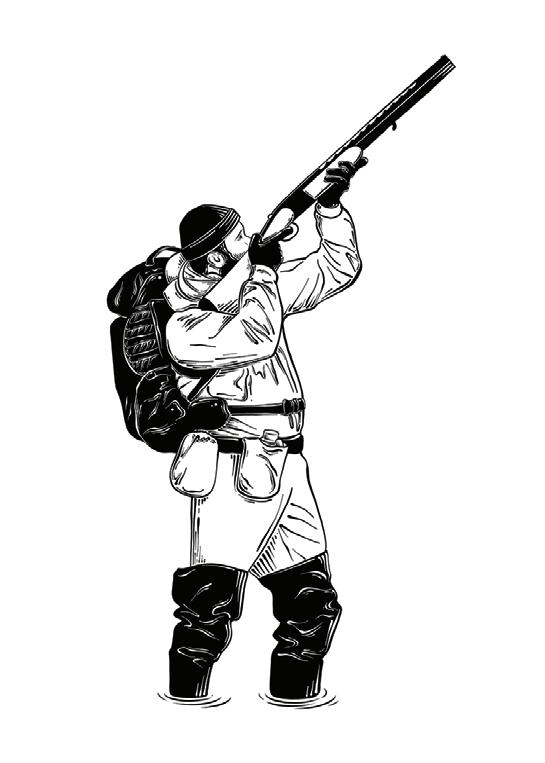
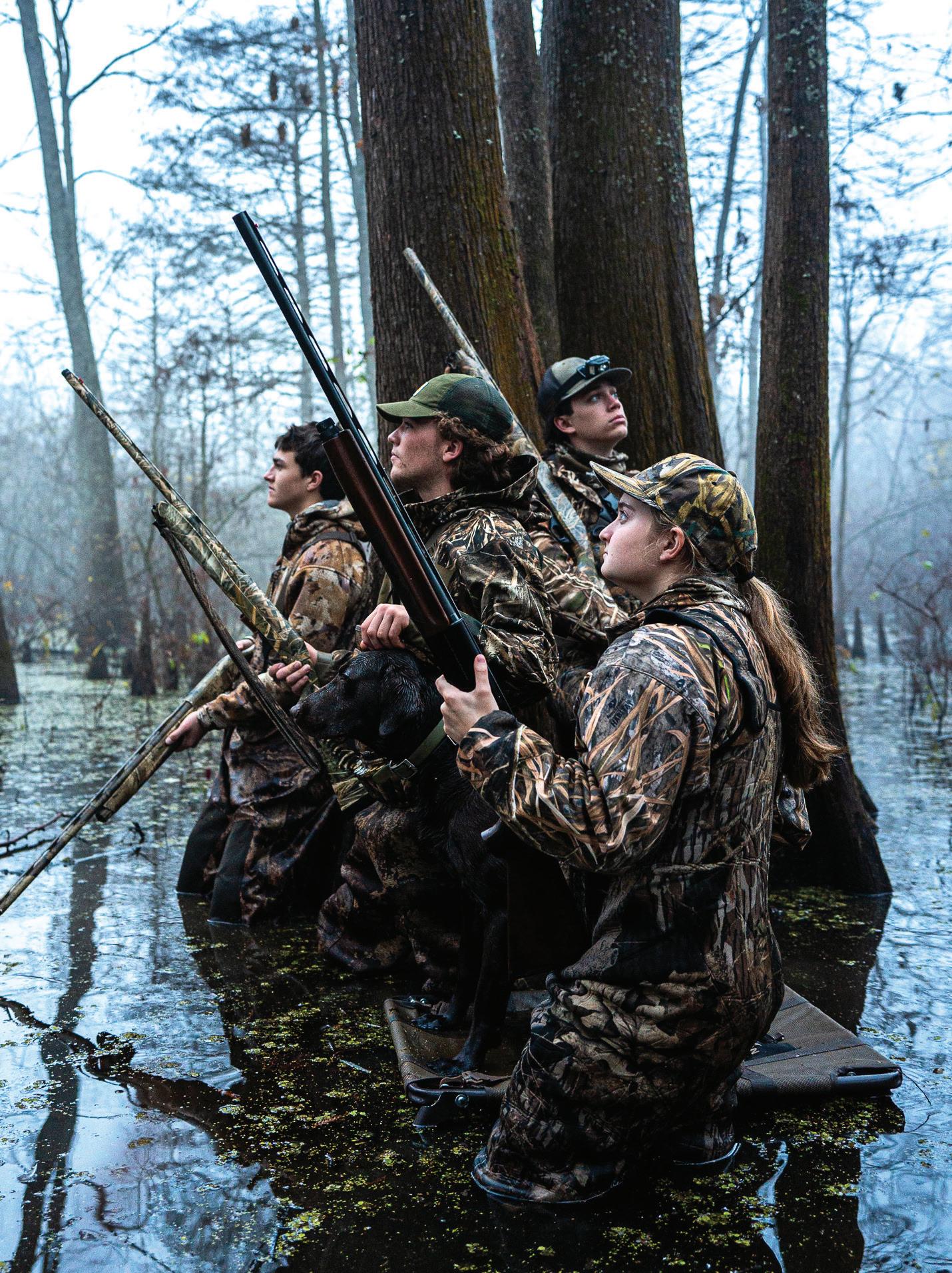
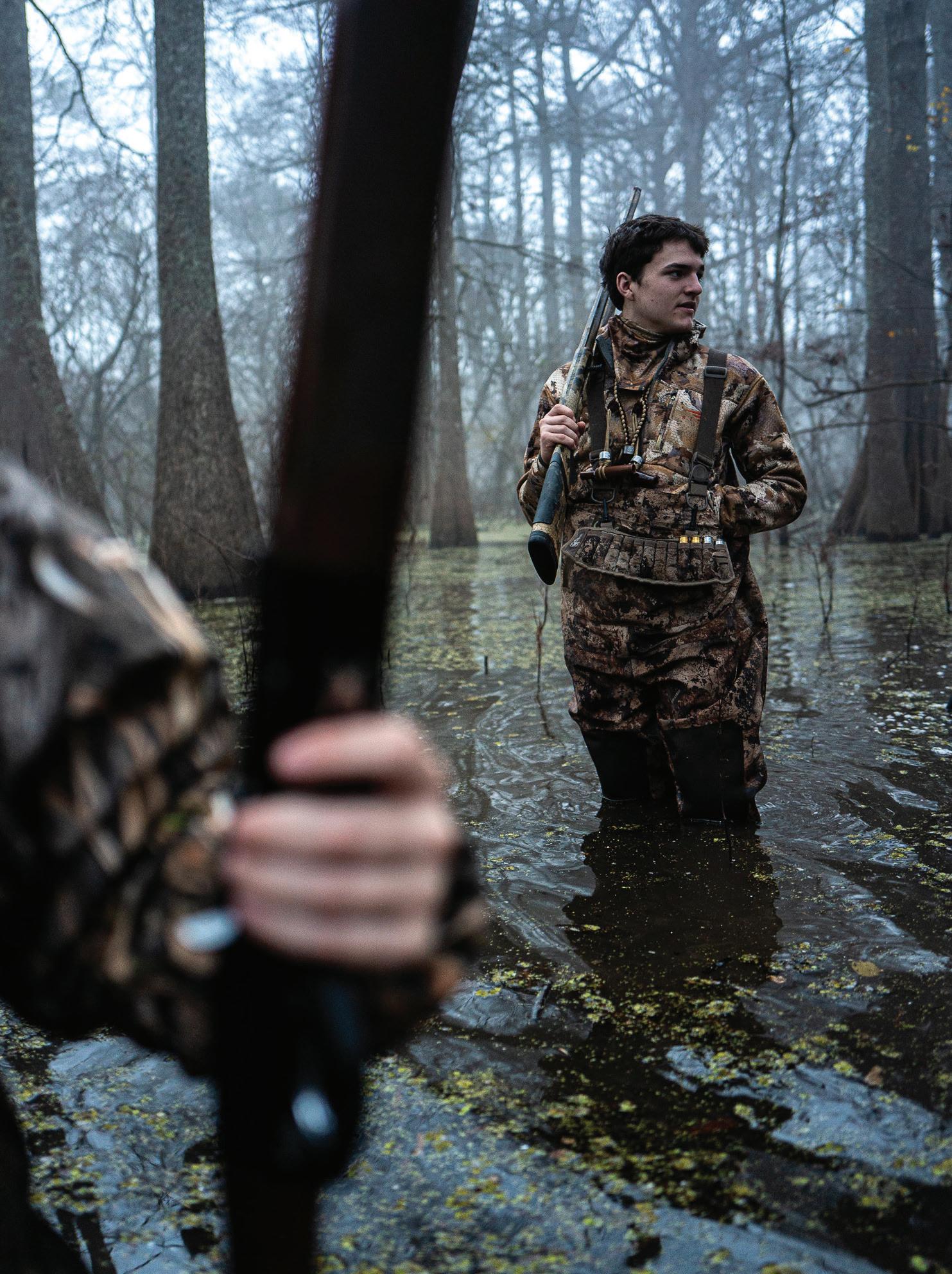
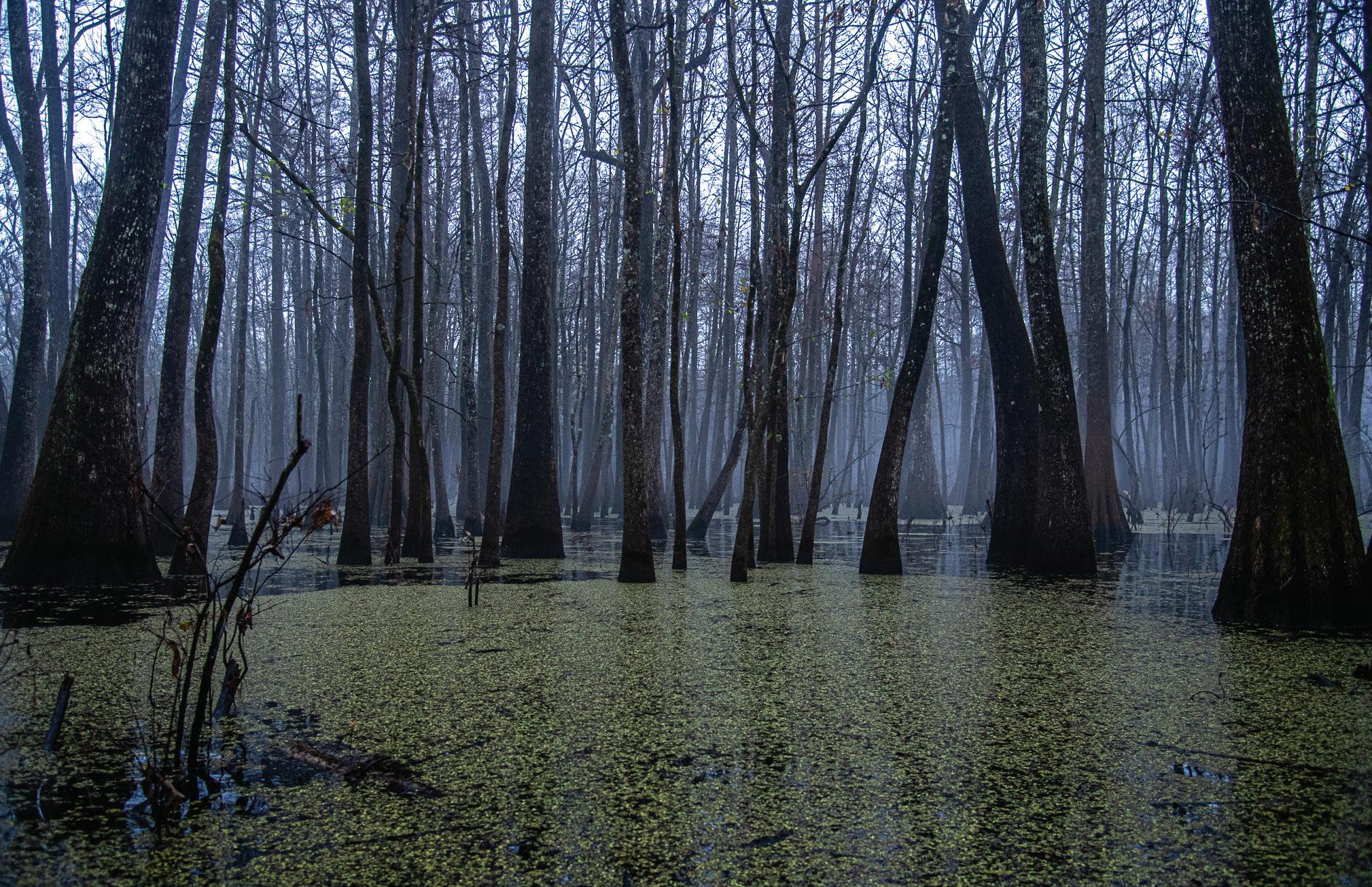
“In flight, or when flushed, females utter an ‘oo-eek’/ ‘cr-r-ek,’ and males have a thin, rising ‘jeeeeee,’ states the Louisiana Department of Wildlife and Fisheries. “Vocal in groups or when in flight, they can also become very vocal when feeding.”
Inside a barn south of Natchitoches, a dozen hunters adjust their shell bags and wader straps. They pack duck calls, gloves, more and more shells, and for a few moments, all chatter ceases. It’s late December, not yet 6 a.m. Already, the temperature creeps toward 70 degrees. Fragments of conversation linger, a mosaic of details.
“That’s where I got a feel for it, in Canada.”
“Whatever you do, always start with salt, black pepper and garlic powder.”
“Up there, you can’t load your shotgun fast enough.”
“You’ve got to marinate that in milk and Louisiana Hot Sauce.”
“It gets into you.”
These last words, Richard Armstrong’s, settle over the silence. Five minutes after he speaks them, they continue to resound, emphatic, an archetypal definition. Hunting: Something that gets into you, often at a young age. Hunting: A skill, typically handed down from one generation to the next that involves guns and ammunition, the sporting pursuit of wild game and the proclivity to rise at hours others consider dreadful.
Through their actions, hunters provide another definition, a vital core. Hunting: to gather as community. And when hunters gather, they trade tales, shuffling through the plot points of hunts past and dreams of those that await. For at the back of a hunter’s mind thrums this certainty: Life is short and the desire to hunt is boundless.
Headlights flicker on and off. One set gets swapped for another. Two hunters exchange gloves, and in the corner of the barn, 16-year-old Hudson Methvin kneels to check his chocolate Labrador’s insulation vest. If Gage didn’t know he would lead a hunt with Hudson a few minutes ago, he certainly does now. Straps secure, Gage darts through the barn, his tail allegro. Alongside his panting rises a new sound. Armstrong and his 16-year-old
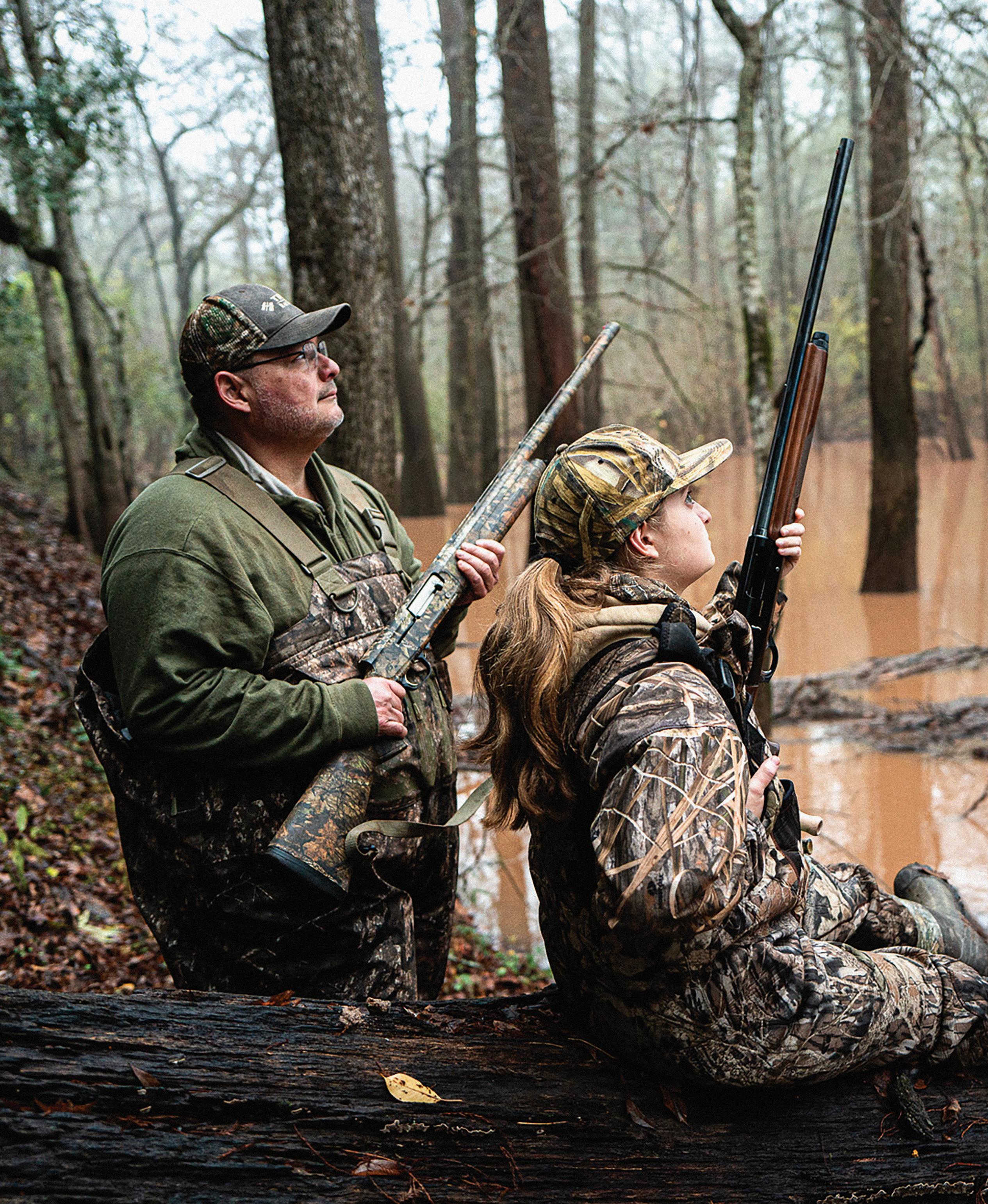

daughter, Camille, hear it too. The forecast predicts heavy rain by 10 a.m. Morning mist becomes drizzle.
“The nastier the weather, the better the hunt,” Richard says. Camille nods. She began hunting with her father at age five. Eleven years on, a competitive shooter who engages in 4-H shotgun competitions throughout Louisiana, Camille’s world already contains a library of hunting stories. She carries the details of those hunts, most of which she has made with Richard, those many mornings when the hunting gods were on her side and she couldn’t reload fast enough, others when they weren’t, but she remained certain of a next time.
Richard Armstrong began taking his daughter Camille hunting when she turned five. Wood ducks are among Camille’s favorite waterfowl to hunt because, she says, they come in “fast and furious. That’s how I like it.”
“But it can be too nasty,” Camille says. “This is just nasty enough.” She inhabits this life, moves with ease inside the skin of a hunter and all it entails, starting and ending with a deep respect for safety. She’s also attained the kind of knowledge of nature and wildlife that one earns only through experience. Imagining her without a hunt or shooting competition on the calendar is like imagining Caitlin Clark without a game to dominate.
In pairs, the hunters step toward four UTVs, or side-by-sides, whose engines hum in the nearby dark. Richard and Camille grab their shotguns and follow. Beside them walk Christie Griffin and her son, Drake, who has recently completed his first season as a tight end for Arkansas State University. “Football is hectic,” Drake says. “It’s a job. Hunting is what I do to get away from it.” At 6’1” and 215 lbs., Drake’s presence fills the dark. And as he walks beside Christie, it’s easy to imagine him at age three, when he first accompanied her on a hunt. Nearly two decades later, Drake smiles at the memory. “At that age, you learn to watch,” he says.
Drake did just that. He studied Christie’s movements, also his father’s. His hunting education involved learning what each hunter must eventually master: the art of patience. At age three, Drake received a lifetime hunting and fishing license. This became a rite of passage in the Griffin family. Drake’s sister also received one when she turned three. “We knew the kids might not love it,” Christie says, “but we also knew that hunting would be a significant part of their lifestyle.”


Hudson Methvin estimates that his chocolate Labrador, Gage, averages more than 50 hunts a year. “Field and Stream” magazine ranks Labradors among the best duck hunting dogs: “Intelligent, highly trainable and eager to please, Labs make great duck hunting dogs and excellent house pets.”

At age four, Drake got his first pellet gun. The next year, he began duck and deer hunting with his parents. They’ve never stopped. Once his fall semester finished, with football on pause, Drake and Christie flew to Arizona to fly fish. They returned to Natchitoches two days ago and on their first morning home set out to fish along the Cane River.
Now they’re on the same land where Chad Methvin began hunting with his father when he turned 14. Methvin brought his oldest son here when he turned that age. By then, Hudson had already been hunting with Chad for nearly a decade. “The killing of ducks is secondary,” Chad says. “Hunting is about spending time with your kids in the same place you hunted with your dad and passing on stories from that time.”
Witness, now, another central aspect of hunting as Chad pulls Hudson aside. The two confer about this morning’s flooded timber hunt. Chad will stay behind to let Hudson lead the way. With this plan, the
group will return to a feast, but what Chad has set in motion — a rite of passage in a hunter’s life — proves more meaningful.
Hudson turns from Chad. He slaps his leg, and Gage leaps into the side-by-side. White lights flood the fallow field, and they depart, four engines droning across the muddy trail. Richard sits in front with no windshield to guard him. Like a boxer, he ducks and weaves to avoid the onslaught of branches that jab and hook from everywhere and all at once. After 800 yards, the engines go silent. The drivers cut the lights. Beside Lake Chicot, a 250-acre swamp, the world returns to darkness.
Gage is first to reach the water’s edge. He drums his paws in anticipation. The day before, Hudson and his cousin Collin Tubre set out with Gage from this same spot. For 200 yards, they waded waist-deep in water, returning with tales of wood ducks and a clearing big enough for a dozen hunters to spread out.
Onto his back, Hudson hoists Gage’s “lift,” a flat adjustable chair that will allow the dog to sit above the cold water and rest when he’s not retrieving ducks. Hudson then steps into the swamp with Gage beside him. The others give them a 10-yard lead before following. Beams of headlamps arc over murky brown water, cypress and tupelos, and somewhere in the impenetrable dark, one hunter says, “Alligator,” causing the others to break into laughter.
Behind them, Camille moves with caution. For the past two years, she’s been a trainer for the St. Mary’s High School football team in Natchitoches. She knows there’s a similarity between the roots and
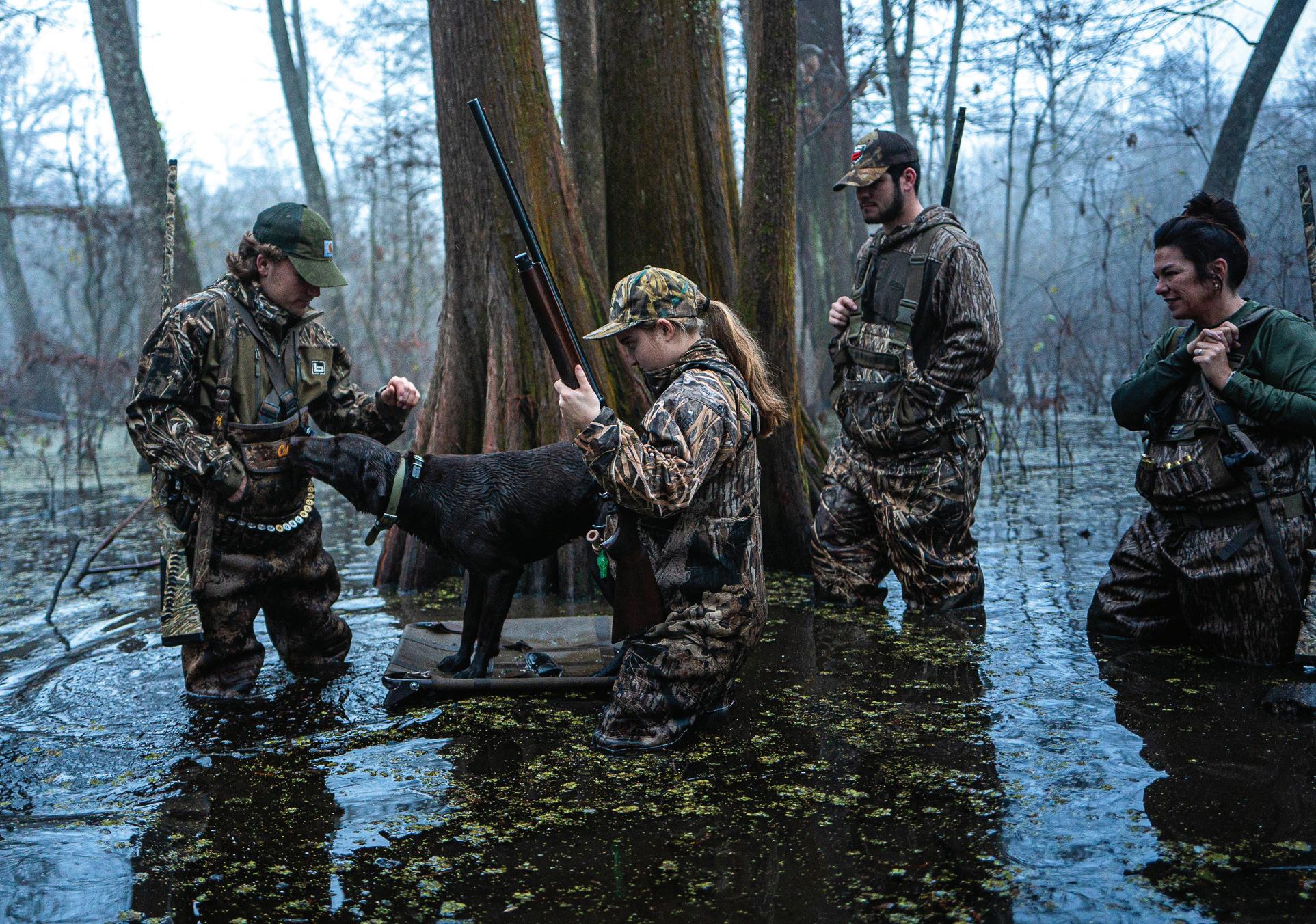
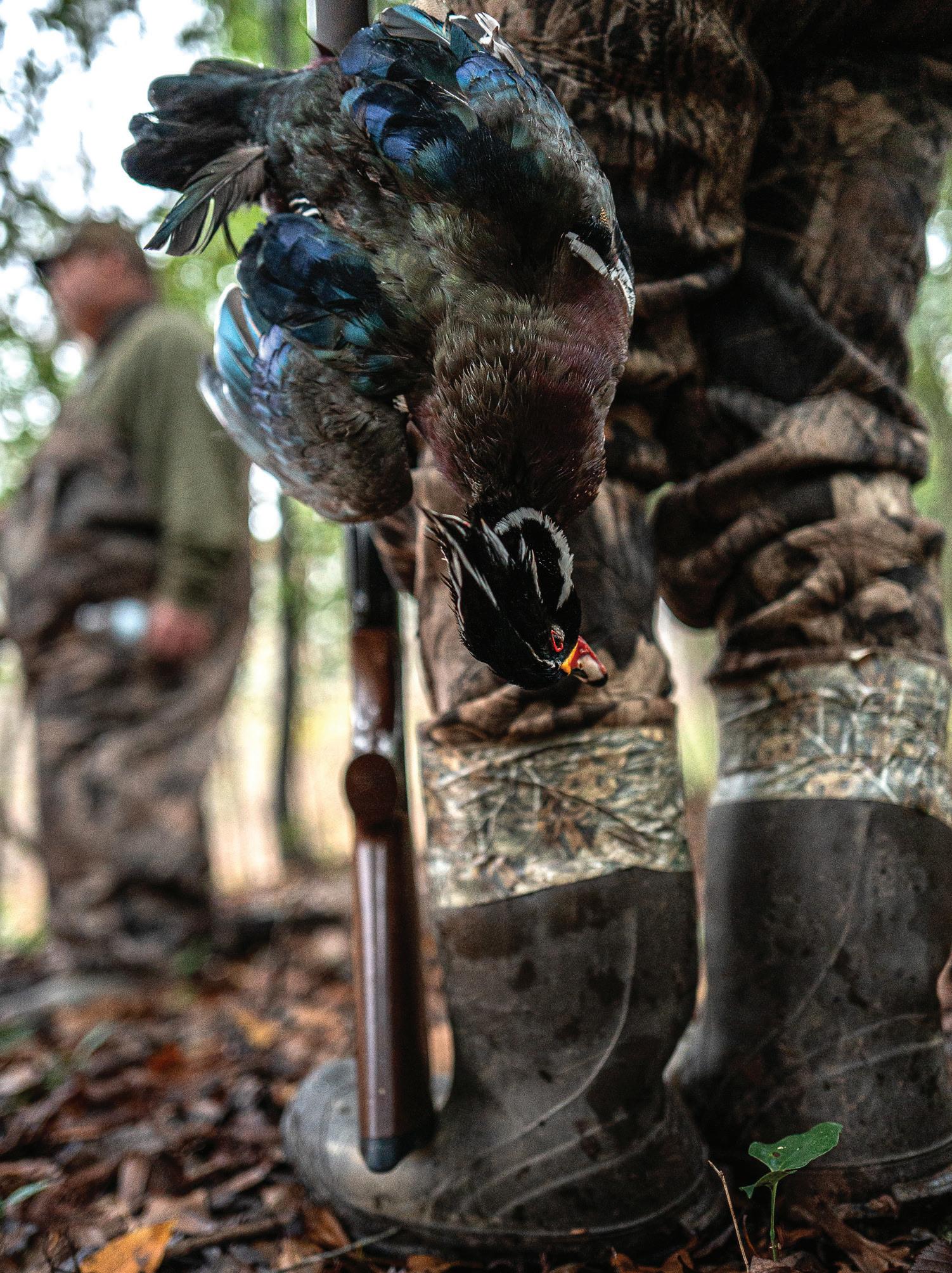
Hudson Methvin, Gage, Camille Armstrong, Christie Griffin and her son, Drake, linger to discuss the morning’s hunt. Based on federal harvest estimates, the Louisiana Department of Wildlife and Fisheries reports that 55,000 active duck hunters harvested 95,000 wood ducks in the state during the 2023-2024 season.
stumps that reach for the ankles and knees and those players on the field whose vocation is to tackle. She grips her 20-gauge shotgun, a Benelli, which she deems “smoother” than the 12-gauge many duck hunters prefer. Camille and the others call out warnings: cypress knee here, sunken limb there and watch out for the hole.
This continues for 15 minutes until they reach Hudson as he adjusts Gage’s lift. In the clearing, the hunters spread out. “Now we wait to see if the ducks will cooperate,” Camille says.
And so they wait. For half an hour, they listen. Cool water laps against their waders. When not clearing drizzle from their brows, they’re drying sweat. And they’re watching, listening. One moment, the swamp is still, silent. The next, they hear the first stirrings, sonorous whistling like an orchestra tuning up before a performance. Camille steps forward. She radiates adrenaline. “When they come, it will be fast and furious,” she says, eyes scanning the oyster-colored sky. “That’s how I like it.”
Three minutes later, the first pair sails across the tree line. And then it comes, report from three shotguns in quick succession. One wave of wood ducks, a second, a third, and during brief gaps, Gage slips into the water to search for downed ducks that he returns to Hudson. Then, just like Camille said, it ends. The early morning wake-up, the preparation, the travel, and after 15 minutes, it’s over.
The hunters begin their walk back to land. “This is a lot of water,” Drake says, laughing even though he didn’t bag any ducks today. In place of wood duck whistling, it’s that sound, laughter, that fills the swamp, a certainty that there will be another hunt.
Inside the kitchen at the farm, they fill their plates with eggs and bacon, muffins and fruit. Camille and Richard settle beside Drake and Christie. They eat and resume their hunting tales, stories of what this life has taught them, all it has given.
“You learn how not to shoot at everything that moves,” Camille says. “You learn to be quiet.”
“Oh, you’ve taught me to be quiet?” Richard says, and there it is, more laughter as they continue eating.
“Ducks also taste pretty good,” Drake says, “especially when you kill a banded one.”
“Every hunter hopes to catch a banded duck at some point,” Christie says.
“You get to see where it comes from,” Drake says, noting that the banded duck he shot in Indiana — the one that wore “jewelry,” as hunters call U.S. Geological Survey waterfowl ID bands — tasted better than any other. After killing banded ducks, at once legal and the white whale of waterfowl hunting, the Louisiana Department of Wildlife & Fisheries encourages hunters to report the tag number for migratory tracking.
Camille looks on with a glimmer in her eye, a yearning to someday score her own jewelry. Beside her, Richard says, “There’s something about being in the water, the sun coming up. You’re out there in nature. You start reminiscing. You think about your grandfather, your father, and you remember all the things you did together, all the stories they told you. You see a different side of people when you’re hunting. Everybody has a job, but when you take them out of that job and put them in God’s creation, it brings out a better side of their nature.”
“Louisiana has approximately 3.5 million acres of coastal marsh that winter large and diverse waterfowl populations,” reports the Louisiana Department of Wildlife and Fisheries. “During 2023-2024, LDWF banded 3,261 wood ducks, a 5% increase from the 3,097 banded last year.”
“You get to pass something on,” Chad says. “That’s the real reason most of us hunt. The quality time we get to spend with our kids is second to none when you’re out there in the woods and learning life lessons.”
“If you grow up with it, you can’t get away from it,” Christie says. And at that, they begin planning the next one. T

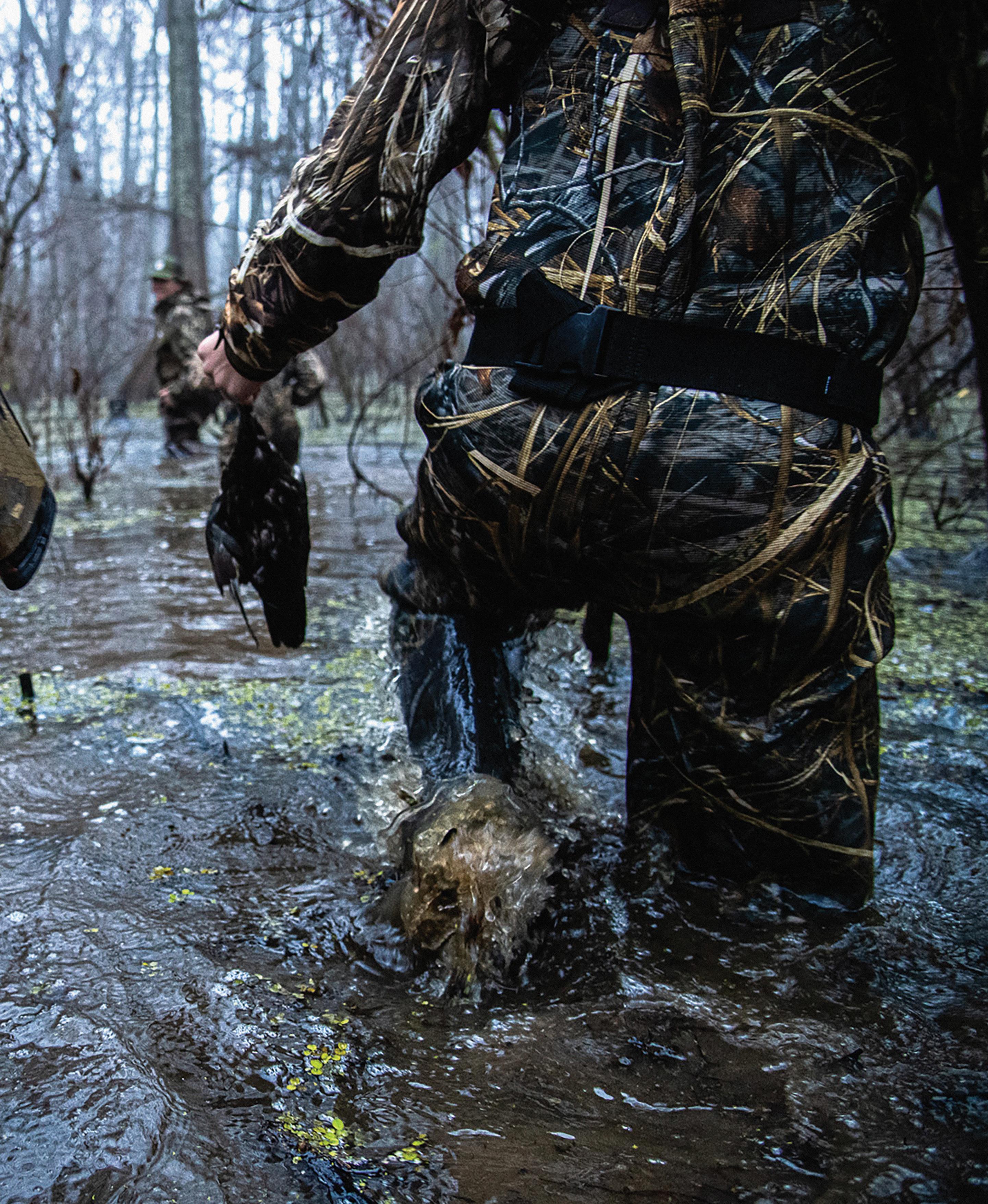


TULANE UNIVERSITY PHYSICIAN-SCIENTIST DR. FRANCK MAUVAIS-JARVIS IS ON A MISSION TO IMPROVE THE HEALTHSPAN OF OLDER WOMEN AND MEN
PERHAPS YOU’VE WATCHED THE DOCUMENTARY “The M Factor: Shredding the Silence on Menopause” released on PBS at the end of 2024. Or maybe you follow one of the many doctor influencers that have popped up on social media in recent years touting the benefits of hormones (or on the darker side, spreading misinformation). It’s probable that, if you are a Generation X woman, you’re discussing hormone therapy for menopause with your friends (hot flashes are merely the tip of the infernal hellscape of symptoms). For years, the topic of hormone therapy for both women and men has been, at the very least, taboo and, at worst, shrouded in fear and confusion. However, physician-scientist Dr. Franck Mauvais-Jarvis has spent 30 years immersed in hormone therapy research and clinical practice and aims to change the conversation.
In his current role at Tulane University School of Medicine as professor of medicine in endocrinology and metabolism, Price-Goldsmith Endowed Professorship and director of the Tulane Center of Excellence in Sex-Based Biology & Medicine, as well as a staff physician in the endocrine service and director of the Hormone Therapy Clinic at the Southeast Louisiana New Orleans VA Medical Center, Mauvais-Jarvis has a unique perspective into the research and clinical sides of hormone therapy.
“Since the 2000s, until let’s say, a few years from now, there has been a period that I call the Dark Ages,” says Mauvais-Jarvis, referring to the now infamous 2002 Women’s Health Initiative Study (WHI). “These results were misrepresented and misinterpreted; some of the statistics were even false [and this] has led to where we’ve been the last 20 years — a fear of hormones.”
The WHI study contributed to various myths that Mauvais-Jarvis and like-minded doctors and medical scientists are on a mission to dispel. The first is that estrogen causes breast cancer. Mauvais-Jarvis says in the WHI study, women without a uterus who took estrogen alone actually had a lower risk of breast cancer and that the minimum risk, which Mauvais-Jarvis says is “not even significant,” was due to the synthetic progestin medroxyprogesterone acetate. “Today, we know that menopausal hormone therapy does not — I repeat, does not — increase the risk of breast cancer.” The second myth is that hormone therapy leads to heart disease. To the contrary, when researchers re-examined the WHI data, they discovered that hormone therapy decreased the risk of heart disease in younger women. The third myth, which Mauvais-Jarvis describes as more of a misconception, is that until recently in the United States, physicians were using conjugated equine estrogen, or estrogen derived from the urine of pregnant mares (Premarin), and medroxyprogesterone acetate, a synthetic progesterone. “These drugs are poison,” says Mauvais-Jarvis. “I never use them. But the bioidentical hormones, the ones that are structurally identical to those
produced by the ovary, estradiol and real progesterone, they produce absolutely no increased heart disease or breast cancer.” While there are often risks to taking certain medications, Mauvais-Jarvis says with bioidentical hormones, estradiol and progesterone, the myriad benefits outweigh the minimal risks. “If you take oral bioidentical estradiol, the protection is that it blocks hot flashes, it prevents osteoporosis, it prevents diabetes in the first 20 years, it probably prevents heart attack, it prevents depression, it prevents Alzheimer’s, it hydrates the skin,” he says. When it comes to testosterone, the myths date to 1966 when Charles Huggins won the Nobel Prize in Physiology or Medicine for his research on the hormonal treatment of prostate cancer. The first myth relates to Huggins’ conclusion that higher testosterone increases the risk of prostate cancer, but more recent studies do not support this finding. “If you look at the literature between 1941 and now, there’s not one paper, not one scientific clinical study that shows you that testosterone increases the risk of prostate cancer,” says Mauvais-Jarvis. “In fact, older men who have low testosterone are at increased risk of prostate cancer and men who have normal testosterone are not at increased risk.” The second myth is regarding testosterone and heart disease. It’s true that synthetic anabolic steroids, which Mauvais-Jarvis describes as a structurally changed form of testosterone that many may confuse with natural testosterone, can increase the risk of heart disease. But, recent studies have shown that testosterone is neutral or may be beneficial to heart function. Mauvais-Jarvis cautions against testosterone therapy for men prior to age 50 who do not have children, because it can cause sterility. The benefits in older men who have low testosterone and symptoms, however, include maintaining sexual health, muscle mass, bone strength, protecting from abdominal fat, plus prevention of depression, Alzheimer's and anemia.
“I consider menopause hormone therapy and testosterone therapy with bioidentical hormones after 50 as the only effective anti-aging therapies,” says Mauvais-Jarvis. “They're not going to make you live longer, but they are going to [help] you live in good shape until the last day. It’s quality of life, it’s healthspan, not lifespan.”
THERE IS ONE MAJOR SOURCE that provides credible ongoing analysis of hospitals: Medicare, which, as the federal health insurance program for people 65 and older, as well as certain younger people with disabilities, often provides funding for many of the big bills. As part of its informational services, medicare.gov reports on evaluations of hospitals based on queries of patients. The Louisiana Life editorial staff sifts through the data every year in order to create a one-of-a-kind list that demonstrates the state’s hospitals according to locality. To qualify for this list, at least 60% of the patients queried had to give the hospital a top overall ranking of 9 or 10 (on a scale from 0 [lowest] to 10 [highest]). These are the top general service hospitals as seen through the eyes of those who have experienced them firsthand — the patients. Note, however, that several hospitals in the state did not have any information available on Medicare’s website and therefore could not qualify to be on the list.

Abbeville General Hospital
118 N. Hospital Drive (337) 893-5466
CHRISTUS Central Louisiana Surgical Hospital
651 N. Bolton Ave. (318) 449-6400
CHRISTUS St. Frances
Cabrini Hospital 3330 Masonic Drive (318) 487-1122
Rapides Regional Medical Center
211 Fourth St. (318) 769-3000
Morehouse General Hospital
323 W. Walnut Ave. (318) 283-3600
BATON ROUGE
Baton Rouge General Medical Center 8585 Picardy Ave. (225) 387-7767
Ochsner Medical Center - Baton Rouge 17000 Medical Center Drive (225) 752-2470
Our Lady of the Lake Regional Medical Center
5000 Hennessy Blvd. (225) 765-6565
Surgical Specialty Center of Baton Rouge 8080 Bluebonnet Blvd. (225) 408-8080
The General 3600 Florida Blvd., Suite 2020 (225) 381-6393
The Spine Hospital of Louisiana
10105 Park Row Circle, Suite 250 (225) 763-9900
Woman’s Hospital 100 Woman’s Way (225) 927-1300
BERNICE
Reeves Memorial Medical Center
409 First St. (318) 285-9066
BOGALUSA
Our Lady of the Angels Hospital
433 Plaza St. (985) 730-6700
BUNKIE
Bunkie General Hospital
427 Evergreen St. (318) 346-6681
BREAUX BRIDGE
Ochsner St. Martin Hospital
210 Champagne Blvd. (337) 332-2178
CHALMETTE
St. Bernard Parish Hospital 8000 W. Judge Perez Drive (504) 826-9500
COLUMBIA
Caldwell Memorial Hospital 441 Main St. (318) 649-6111
Citizens Medical Center
7939 U.S. Highway S. (318) 649-6106
COVINGTON AVALA 67252 Industry Lane (985) 809-9888
St. Tammany Parish Hospital
1202 S. Tyler St. (985) 898-4001
Acadia General Hospital
1305 Crowley Rayne Highway (337) 783-3222
DELHI
Richland Parish Hospital - Delhi
407 Cincinnati St. (318) 878-5171
DERIDDER
Beauregard Memorial Hospital
600 S. Pine St. (337) 462-7100
EUNICE
Acadian Medical Center
3501 Highway 190 (337) 580-7903
FARMERVILLE
Union General Hospital
901 James Ave. (318) 368-9751
FORT JOHNSON SOUTH
Bayne-Jones Army Community Hospital 1585 Third St. (337) 531-3118
FRANKLIN
Bayou Bend Health System
1097 Northwest Blvd. (337) 828-0760
HAMMOND
Cypress Pointe Surgical Hospital
42570 S. Airport Road (985) 510-6200
North Oaks Medical Center 15790 Paul Vega MD Drive (985) 345-2700
HOMER
Claiborne Memorial Medical Center
620 E. College St. (318) 927-2024
HOUMA
Leonard J. Chabert Medical Center
1978 Industrial Blvd. (985) 873-2200
Physicians Medical Center
218 Corporate Drive (985) 853-1390
Terrebonne General Health System 8166 Main St. (985) 873-4141
INDEPENDENCE
Lallie Kemp Medical Center 52579 Highway 51 S. (985) 878-9421
JENNINGS
Ochsner American Legion Hospital 1634 Elton Road (337) 616-7000
JONESBORO
Jackson Parish Hospital 165 Beech Springs Road (318) 259-4435
KAPLAN
Abrom Kaplan Memorial Hospital 1310 W. Seventh St. (337) 643-8300
KENNER
Ochsner Medical Center - Kenner
180 W. Esplanade Ave. (504) 468-8600
KINDER
Allen Parish Hospital 108 Sixth Ave. (337) 738-2527
Lafayette Surgical Specialty Hospital 1101 Kaliste Saloom Road (337) 769-4100
Ochsner Lafayette General Medical Center
1214 Coolidge St. (337) 289-7991
Ochsner University Hospital and Clinics 2390 W. Congress St. (337) 261-6000
Our Lady of Lourdes Regional Medical Center
4801 Ambassador Caffery Parkway (337) 470-2000
Park Place Surgical Hospital 4811 Ambassador Caffery Parkway (337) 237-8119
CHRISTUS Ochsner Lake Area Hospital 4200 Nelson Road (337) 474-6370
CHRISTUS Ochsner St. Patrick Hospital
524 Dr. Michael DeBakey Drive (337) 436-2511
Lake Charles Memorial Hospital
1701 Oak Park Blvd. (337) 494-3000
East Carroll Parish Hospital
336 N. Hood St. (318) 559-4023
Byrd Regional Hospital 1020 Fertitta Blvd. (337) 239-9041
St. Charles Parish Hospital 1057 Paul Maillard Road (985) 785-3644
St. James Parish Hospital 1645 Lutcher Ave. (225) 869-5512
Savoy Medical Center 801 Poinciana Ave. (337) 468-5261
MANSFIELD
DeSoto Regional Health System 207 Jefferson St. (318) 872-4610
MANY
Sabine Medical Center 240 Highland Drive (318) 256-5691
MARKSVILLE
Avoyelles Hospital 4231 Highway 1192 (318) 253-8611
MARRERO
West Jefferson Medical Center
1101 Medical Center Blvd. (504) 347-5511
East Jefferson General Hospital 4200 Houma Blvd. (504) 503-4000
MINDEN
Minden Medical Center
One Medical Plaza (318) 377-2321
MONROE
Monroe Surgical Hospital 2408 Broadmoor Blvd. (318) 410-0002
Ochsner LSU Health - Monroe Medical Center 4864 Jackson St. (318) 330-7000
St. Francis Medical Center
309 Jackson St. (318) 966-4000
MORGAN CITY
Ochsner St. Mary 1125 Marguerite St. (985) 384-2200
Natchitoches Regional Medical Center 501 Keyser Ave. (318) 214-4200
NEW IBERIA
Iberia Medical Center 2315 E. Main St. (337) 364-0441
NEW ORLEANS
New Orleans East Hospital 5620 Read Blvd. (504) 592-6600
Ochsner Medical Center Acute 1516 Jefferson Highway (504) 842-3000
Southeast Louisiana Veterans Health Care System
2400 Canal St. (800) 935-8387
Touro Infirmary 1401 Foucher St. (504) 897-7011
University Medical Center New Orleans 2000 Canal St. (504) 702-3000
Oakdale Community Hospital
130 N. Hospital Drive (318) 335-3700
West Carroll Memorial Hospital 706 Ross St. (318) 428-3237
Hardtner Medical Center 1102 N. Pine Road (318) 495-3131
Opelousas General Health System 539 E. Prudhomme St. (337) 948-3011
Alexandria VA Medical Center 2495 Shreveport Highway (318) 473-0010
Ochsner St. Anne General Hospital 4608 Highway 1 (985) 537-6841
RAYVILLE
Richardson Medical Center
254 Highway 3048 (318) 728-4181
CHRISTUS ShreveportBossier Health System 1453 E. Bert Kouns Industrial Loop (318) 681-5000
Ochsner LSU Health
Shreveport 1541 Kings Highway (318) 675-5058
Ochsner LSU Health
Shreveport - St. Mary Medical Center One St. Mary Place (318) 626-4300
Overton Brooks VA Medical Center
510 E. Stoner Ave. (318) 221-8411
Specialists Hospital
Shreveport 1500 Line Ave. (318) 213-3800
Willis Knighton North 2600 Greenwood Road (318) 212-4001
Our Lady of the Lake Surgical Hospital 1700 Lindberg Drive (985) 280-2200
Slidell Memorial Hospital 1001 Gause Blvd. (985) 643-2200
Sterling Surgical Hospital 989 Robert Blvd. (985) 690-8200
Springhill Medical Center
2001 Doctors Drive (318) 539-1000
West Calcasieu
Cameron Hospital
701 Cypress St. (337) 527-7034
Thibodaux Regional Medical Center
602 N. Acadia Road (985) 447-5500
Mercy Regional Medical Center
800 E. Main St. (337) 363-5684
North Caddo Medical Center
815 S. Pine St. (318) 375-3235
Glenwood Regional Medical Center
503 McMillan Road (318) 329-4200
Winn Parish Medical Center
301 W. Boundary Ave. (318) 648-3000
Franklin Medical Center
2106 Loop Road (318) 435-9411
Lane Regional Medical Center
6300 Main St. (225) 658-4000


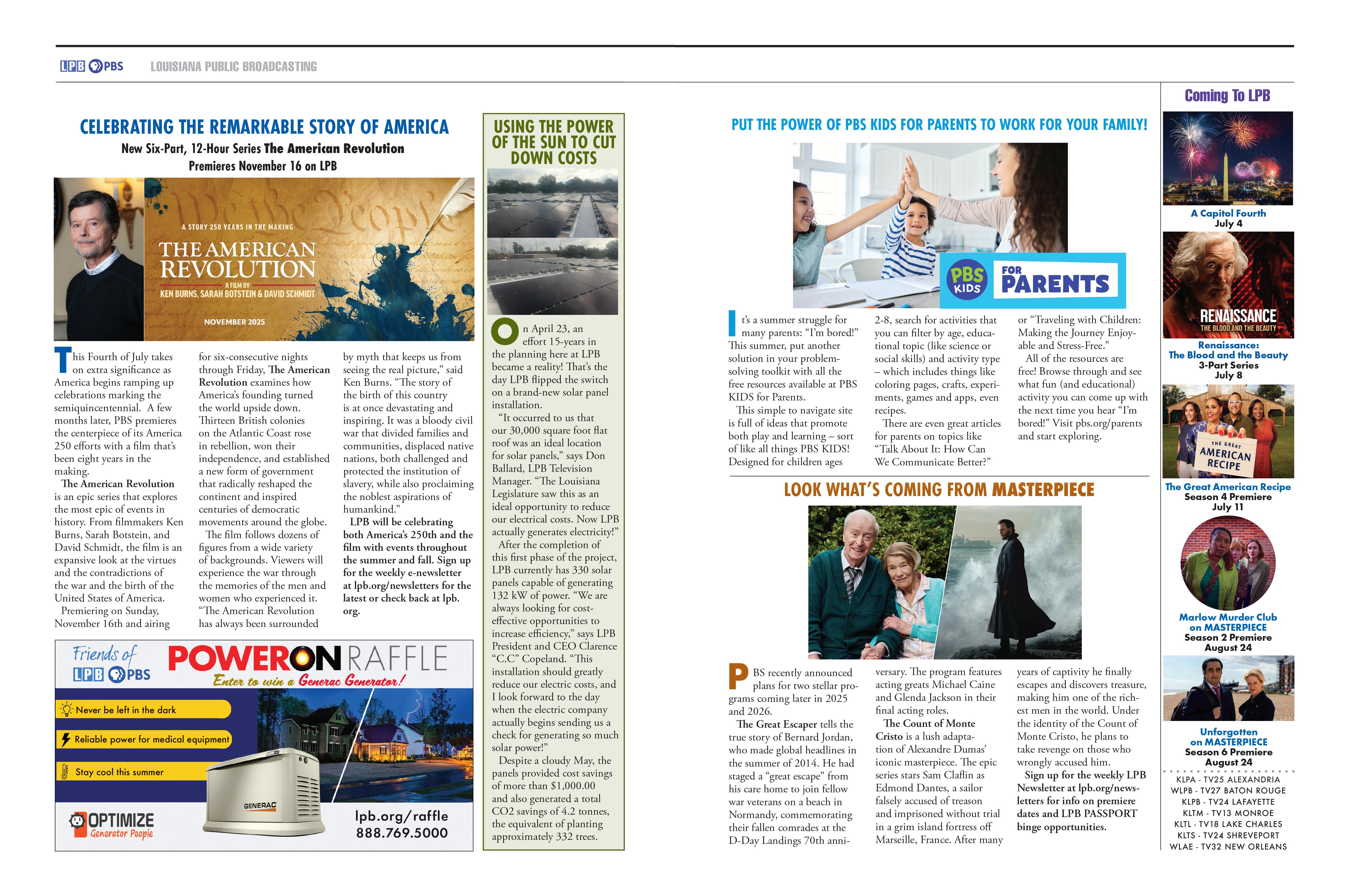

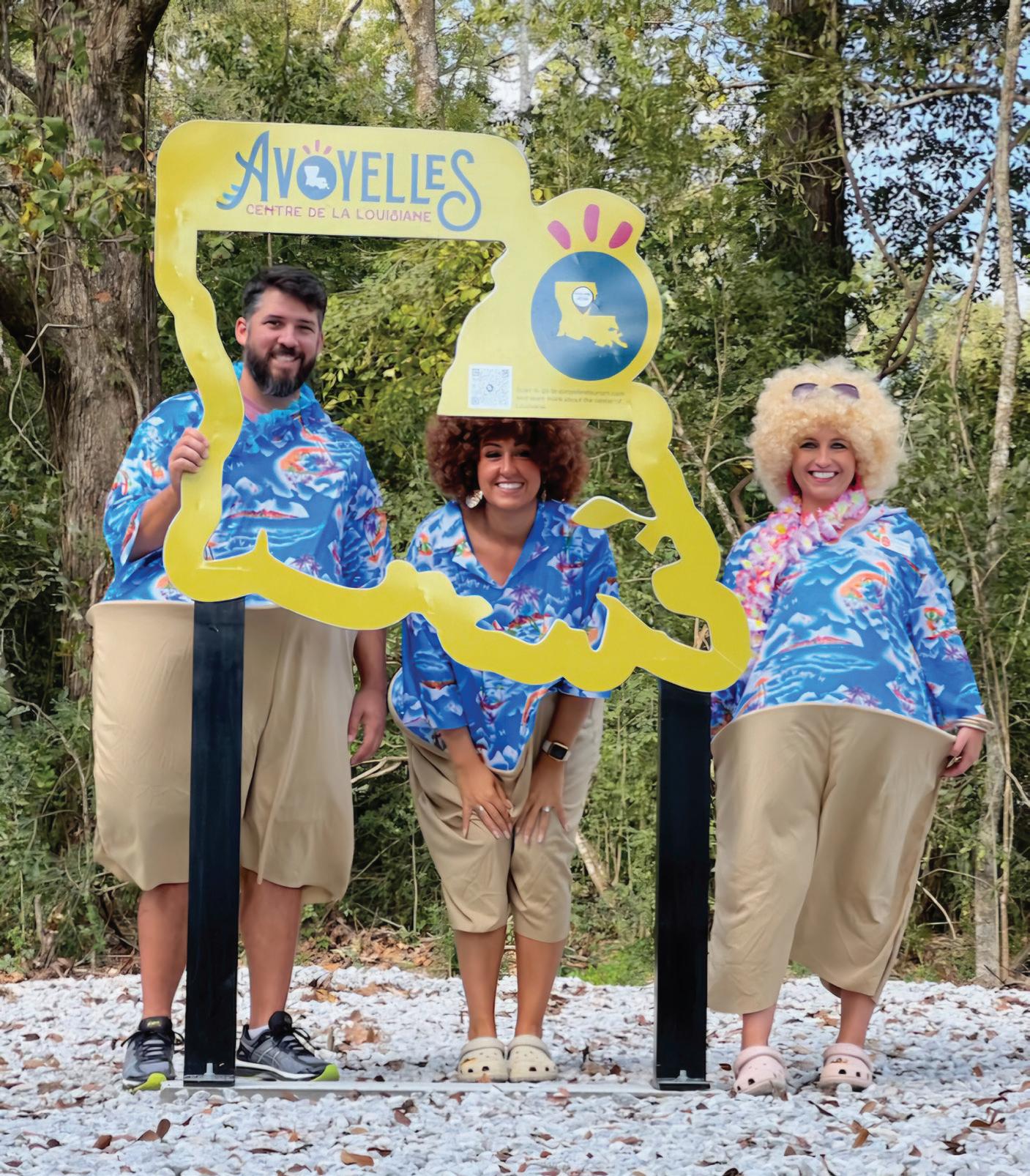
DOWN THE BAYOU OR JUST UP THE STREET, THERE’S SOMETHING NEW AND EXCITING FOR YOU TO DISCOVER AROUND EVERY CORNER OF LOUISIANA!
Shreveport-Bossier is packed with familyfriendly fun this summer! Visit Gators and Friends to race go-karts, feed alligators, explore the exotic petting zoo, and zip-line over the park. At Sci-Port Discovery Center, kids can unleash their curiosity with hands-on exhibits, an IMAX dome, planetarium shows, and interactive science galleries for all ages. Dive into aquatic adventures at the Shreveport Aquarium, where guests can touch stingrays, feed sea creatures, and explore shipwrecks, coral reefs, and deep-sea habitats. Laze down the lazy river at Wonder Oasis Waterpark or slide down the various slides for more adventure. Head to Cypress Zoo, nestled in the Black Bayou Recreation Area, where families can enjoy walking trails, petting zoos, and beach spots. Check out the brand-new Chasing Aces, a golf experience with a putting course, par-3
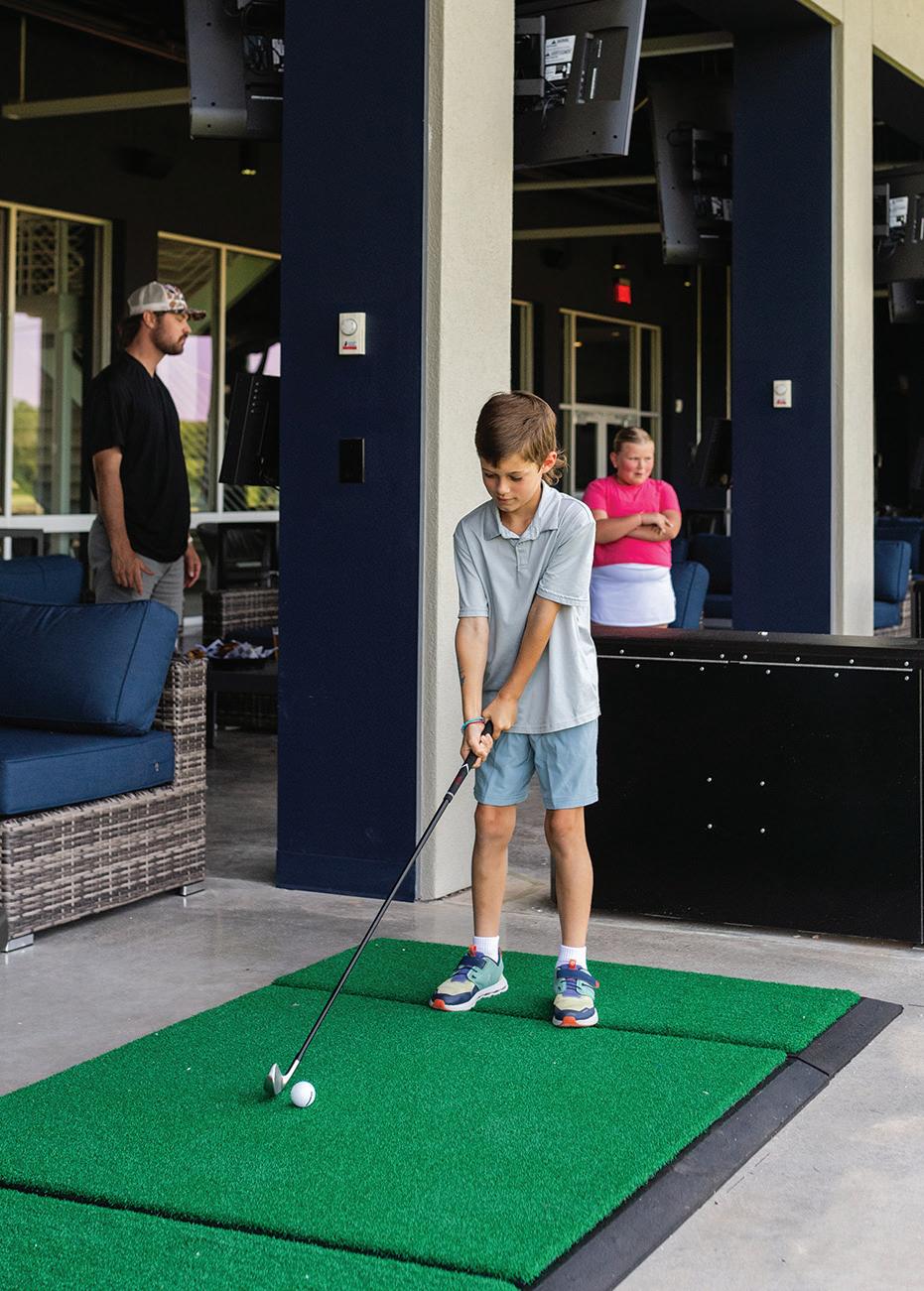
challenges, and a fun atmosphere perfect for beginners or pros. There’s no shortage of ways to make memories in Shreveport-Bossier this summer!
For more information visit visitshreveportbossier.org
The West Baton Rouge Convention & Visitor Bureau grounds will be center stage, once again, for the Annual Smokin’ Oldies BBQ Cook-Off. This event is a BCA State Championship Cook-Off held on Saturday, September 13th. Come out and watch the competition while dancing to the music of Justin Cornett from noon to 4 p.m. Visit the local crafters and Louisiana food booths. Then on Sunday, September 14th, the Oldies But Goodies Fest begins at 11:00 a.m. with Waters Edge performing from noon to 4 p.m. Come out and enjoy the antique car show, local crafts, and Louisiana food booths.
For more information on these events, please visit westbatonrouge.net
As you travel the roads of Louisiana this summer into fall, take a backroad trip to the center of Louisiana, yes that is correct,

Avoyelles Parish boasts the coordinates to CENTRE de la LOUISIANE, 31.0693876La, -91.9970055Lo. The physical address is 1860 Old River Road, Mansura, LA 71350. Come on out and take a selfie in Louisiana’s center and share your history making photo with us on FB: TravelAvoyelles.
When you visit Avoyelles, you’ll get Louisiana your way. A laid-back stroll down a charming main street –it’s here! Cultural attractions in a beautiful natural setting –that’s us too! And the thrills of a Vegas-style casino with a bounty of entertainment and dining. When was the last time you visited a service station where an attendant pumped your gas and wiped your windshield sides along a historic highway? You’ll find it all and more when you find your center in Avoyelles!
Known as the Happiest City in America, Lafayette is the lifeblood of Cajun & Creole Country, brimming with culture as unique as the sounds and flavors of its people. With the Summer sun shining, there’s no better place to visit for a festival, outdoor adventure, or just a great bite to eat than Acadiana.
If you’re looking for your next culinary obsession, Lafayette Travel has you covered
with a Foodie’s Guide to Lafayette that will send your taste buds dancing. Whether you’re in the mood for some classic Creole fare (BJ’s Poorboy and Plate Lunches or Pop’s Poboys), some local brews (Adopted Dog Brewing), or sample a plate of international fare, Cajun style (Bailey’s Tandoori Grill, Agave Downtown, or Central Pizza & Bar), there’s a fit for every appetite down Lafayette way.
Left to Right: Avoyelles; Shreveport-Bossier; Lafayette; West Baton Rouge
There’s always something new to taste and see in Acadiana, where Louisiana goes to party. Learn more by visiting lafayettetravel.com/food-drink/food-tours/ foodies-guide/ or lafayettetravel.com/ food-drink/local-restaurants/ today!
This summer, camp inside one of the world’s largest pyramids at Big Cypress Lodge. Nestled inside the iconic Memphis Pyramid, this luxury hotel offers rustic rooms with inviting fireplaces, balconies overlooking Bass Pro Shops, and plush furnishings for a glamping-style retreat. Complete with dining options, spectacular shopping, and adventurous activities, Big Cypress Lodge is where your next family getaway begins. Plus, the convenient downtown location and complimentary shuttle give you access to the city’s best attractions and entertainment.
Join us this Summer for Yoga on the River every Tuesday by the Downtown Memphis Commission, the Ducks Unlimited Expo at the Renasant Convention Center August 1 – 3rd, and the Mississippi River Monster Tournament, and “The Home of the Blues” on Memphis’ Historic Beale Street. There’s always something new around every corner of Memphis, and Big Cypress Lodge is at the heart of it all.
Learn more at big-cypress.com.T

STORY AND PHOTOS BY KEVIN RABALAIS
BEHIND THE WOODWORTH TOWN HALL parking lot looms a sliver of forest sandwiched between asphalt and concrete. That’s a hint of encouragement since the U.S. Forest Service website directs hikers here to access the Wild Azalea Trail — at approximately 31 miles, Louisiana’s longest hiking path. But after several reconnaissance trips up and down the tree line, there’s no sign of a path, much less a trailhead.
“I went to the woods because I wished to live deliberately, to front only the essential facts of life, and see if I could not learn what it had to teach, and not, when I came to die, discover that I had not lived,” wrote Henry David Thoreau in “Walden.” Had he lived in a time of smart phones and improperly updated websites, Thoreau might have stayed on his couch, I think. Then I remember a golden age when convenience store clerks knew directions everywhere.
At the Exxon station across the street, half a dozen people stroll the aisles, all friendly but none from Woodworth. No one has heard of the Wild Azalea Trail,
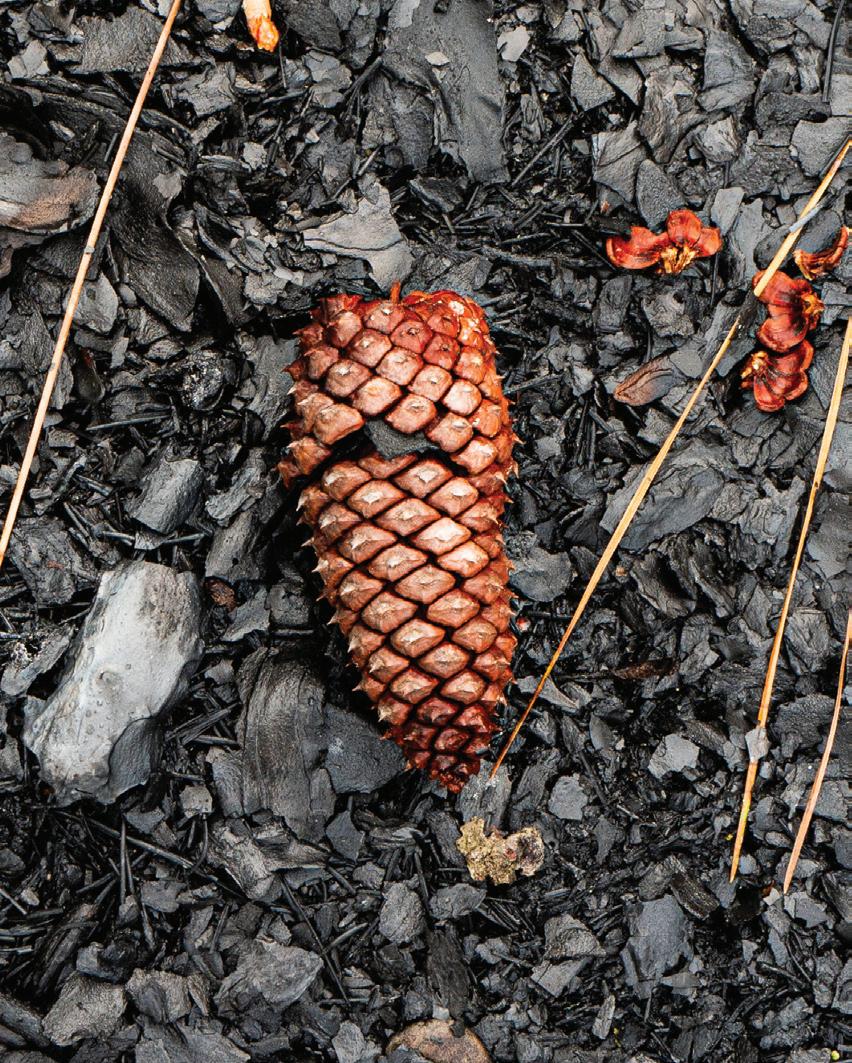
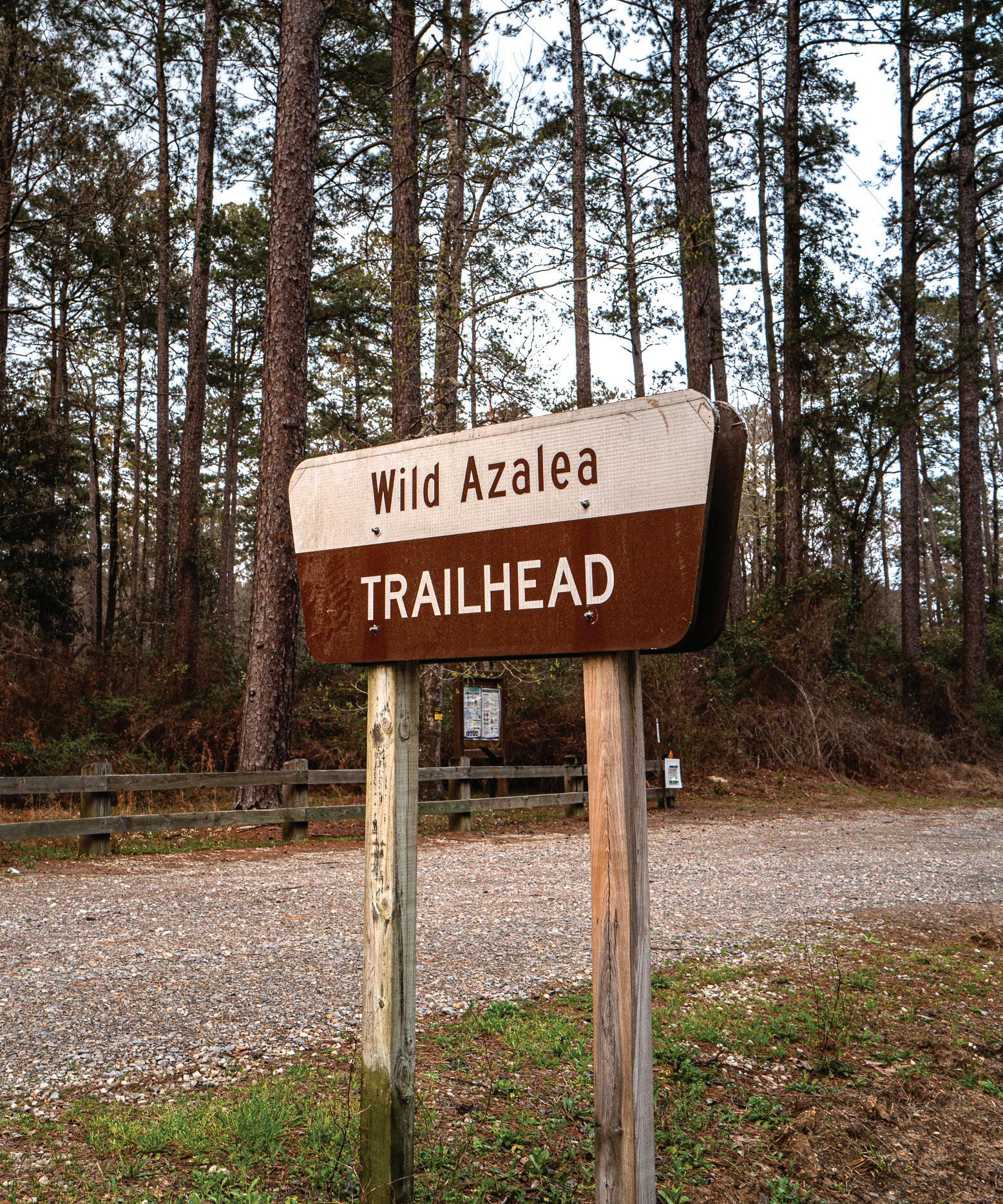
and none remembers a time when a different Town Hall parking lot led to the great outdoors. One cashier suggests Valentine Lake Recreation Area, nearly 20 miles away. The Forest Service website offers this as the other entry point to the Wild Azalea Trail, but I’m committed. I want a trail, and I want it where Google says it is.
“Ask at Indian Creek,” she says, and since that’s closer than Valentine Lake, I travel five minutes southeast only to find an empty welcome booth. Meanwhile, the day is fading, and I can feel my hair turning gray like it does when the Saints are down. There’s also the problem of Friedrich Nietzsche. “Never trust a thought that occurs to you indoors,” warned the German philosopher, a directive that has caused me to cross-examine most of my recent musings. Still, I’m certain of this: Kisatchie National Forest is near, and inside it awaits the Wild Azalea Trail.
Back at the Woodworth Town Hall, a black SUV runs idle in the parking lot. Grabbing my camera and bag, I dash across 50 yards of pristine lawn hoping to catch the driver before he peels away. With each step, I become more certain that he will nod casually to a massive trailhead and confirm that my refrigerator blindness has metastasized.
Located southwest of Alexandria, the Wild Azalea Trail is a part of the Evangeline Unit of the Calcasieu Ranger District of Kisatchie National Forest. Designated for hiking and cycling, the trail’s start and finish points are at Valentine Lake Recreation Area near Gardner and Castor Plunge Road/FS287 near Woodworth.

Rapides Parish
DID YOU KNOW?
Some entities measure the Wild Azalea Trail at 31 miles, others at 28 or 24.1. The trail route is conspicuously marked with bright yellow paint blazes. State Highway 488 bisects the trail near its midpoint. It is also accessible by road at several other locations. This makes it possible to hike short sections, a convenience for those who don’t have time to hike the entire trail in one outing. The U.S. Forest Service suggests to plan 16 hours to hike the entire trail.

Each step also convinces me that I’m starting to look like a desperate paparazzo. But I arrive to see that he has a smartphone to distract him, so I windmill my arms to appear even more deranged.
“I want to hike,” I say as his window lowers, aware for the first time that “hike” and “hijack” have a few awkward similarities. “The website says —”
“That was a long time ago,” he says with no trace of fear or small-town suspicion. “Follow me.”
The well-marked and well-traveled trail transitions from flat to rolling terrain as it winds through pine hills, hardwood bottoms and narrow creeks. March and April are the best times to spot the wild azaleas for which the trail is named. Because the trail is located within Kisatchie National Forest, signage cautions hikers that logging may be taking place in the area. Before hiking, check with Kisatchie National Forest for its prescribed burn schedule.
A minute later, I latch onto his bumper. A quick right, and as we wind along Castor Plunge Road, my confidence in a bona fide trailhead rekindles. I can also hear Vivien Leigh as Blanche DuBois going on about the kindness of strangers. Then the driver turns into an empty parking lot with a glorious trailhead.
Through his window, he offers a business card and friendship badge with his name on one side and the U.S. flag on the other. “David Butler,” he says. “Mayor of Woodworth.” The moment seems so scripted that I tell myself not to look around for the film crew. He then confirms a previously located Town Hall and an out-ofdate Forest Service website. “It’s probably time they change that,” he says. Then he drives away.
“There are no bad experiences,” writes adventurer Tim Cahill, a reminder that travail forms the root of travel, and travail stems from the Latin tripaliare, to torture. Cahill’s optimism proves particularly apt when it comes to our excursions in the natural world. Florence Williams’ 2017 book, “The Nature Fix,” reports scientific studies that show how a 15-minute walk in the woods can reduce stress levels. Subjects who spent 45 minutes in nature saw
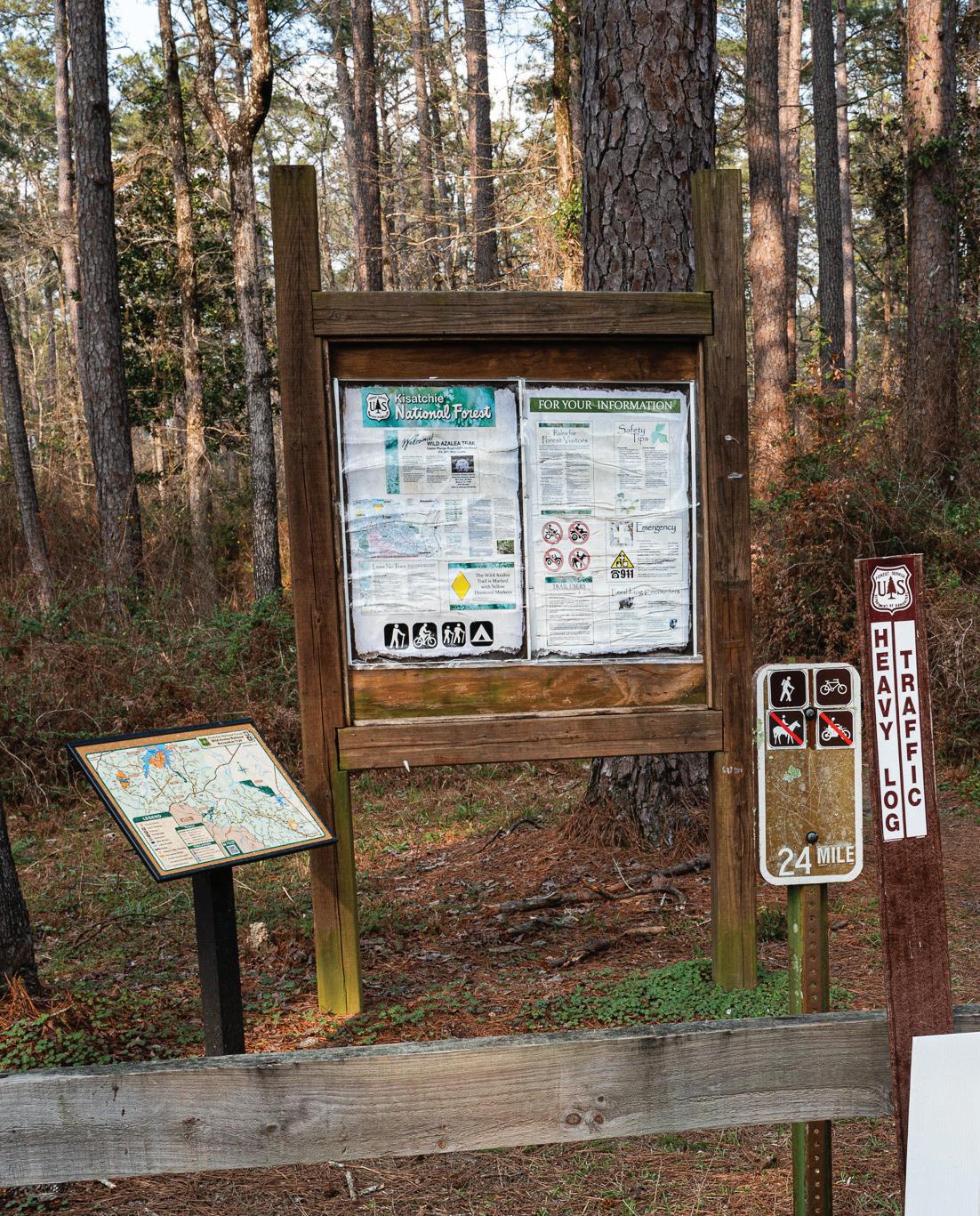
enhanced abilities to think, remember, focus, dream and an increased desire for generosity. “Nature, it turns out, is good for civilization,” Williams writes.
The hum of the mayor’s SUV has faded. Now surrounded by pines slightly charred from a recent prescribed burn, the sole audience of a wondrous birdsong symphony, I set out. And soon, I begin to forget all the things I worry about that never happen anyway.
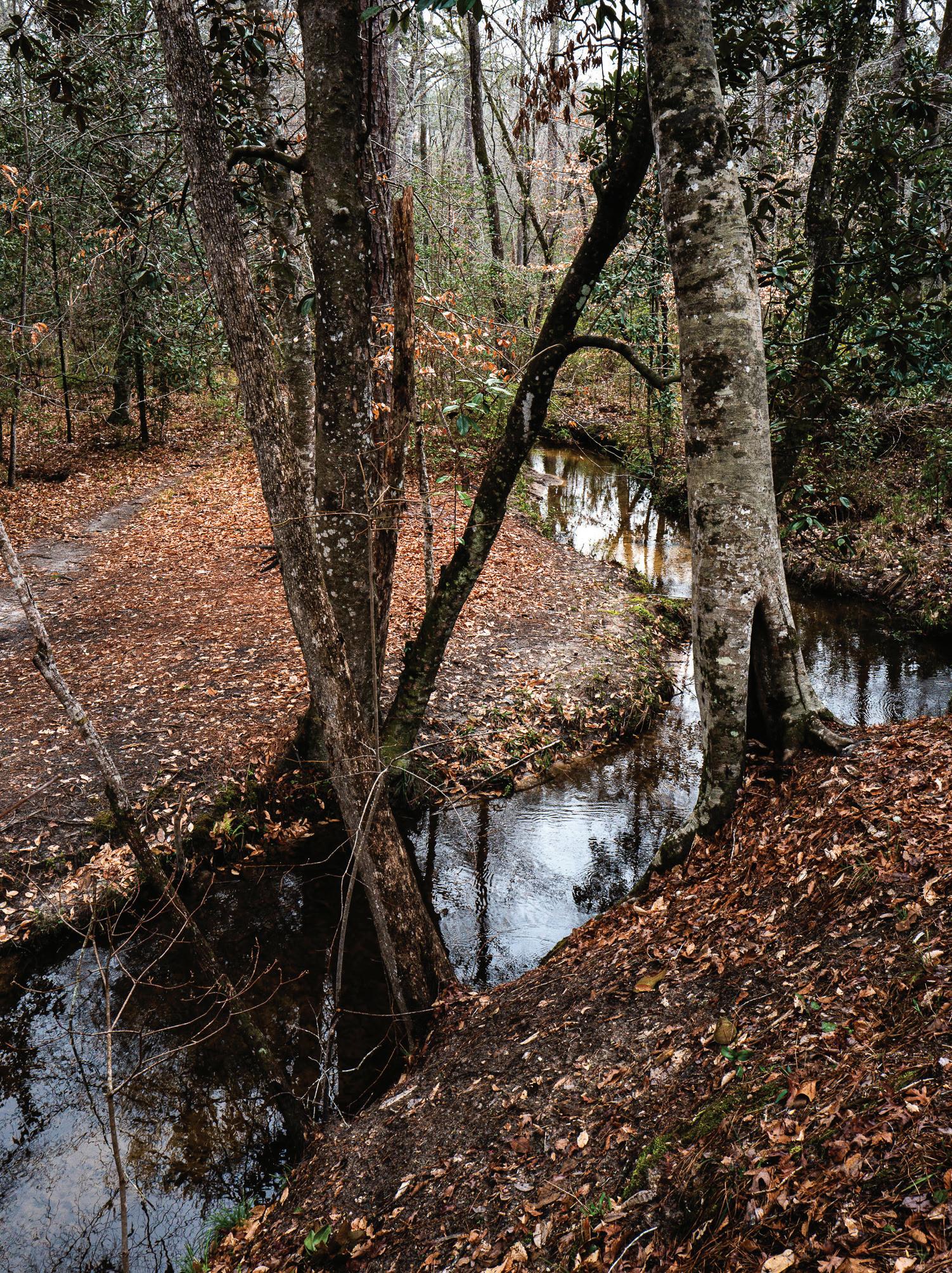
In its perfectly preserved historic downtown, Hammond marries college vibes with a vibrant dining and cultural scene.
STORY AND PHOTOS BY MELANIE WARNER SPENC ER
THE INFATUATION, as so many do, began over a cup of coffee. Specifically, an oat milk latte made with precisely measured and pulled espresso using thoughtfully sourced and expertly roasted beans. Luma Coffee — housed in the circa-1890s historic Central Rexall Drugs in Hammond and one of downtown’s oldest buildings — is one of several delights I was surprised to find in the small city (albeit largest in Tangipahoa Parish). As I wandered around Hammond’s spectacularly preserved downtown with its boundless brick buildings and nearby movie set-worthy, historic Illinois Central Railroad train depot (a working Amtrak stop), I played the age-old “what would it be like to live here” game. Yes, I Googled housing prices and yes, there are some great deals.
To disabuse myself of gingerbread Victorian cottage daydreams, I ducked into Batter — an adorable, pink-infused bakery — to grab a huge, puffy strawberries and cream cookie filled with cream cheese frosting. (Y’all, this gigantic dang cookie was so rich I could only eat half.)

It is easy to see why Hammond won the Great American Main Street Award in 2022. The Railroad Park highlights the city’s history as a stop on the Great Northern Railroad, while also serving as a gorgeous community space with a colorful mural, stage for live entertainment, inviting benches and a clock nestled amid flourishing flowers and saplings. This space gives off major town square vibes, while also offering up loads of railroad history via markers along the long brick wall enclosing the park.
Nearby Cate Square Park, with its gazebo and wealth of stately oak trees,


and the residential and commercial architecture from the late 1800s and early 1900’s mixed with midcentury buildings was not helping my case of I-should-movehere-itis. If that wasn’t enough, Southeastern Louisiana University provides an influx of students that contributes to a youthful energy.
That vitality is furthered in bars like the new Eclipse, next door (and connected to) the equally new seafood restaurant, Lighthouse Coastal Brasserie. Kaleb, a bartender at One Thirteen, the chic American bistro owned by the same group as Lighthouse and Eclipse, was mixing up one of the best mocktails I’ve had in ages (a non-alcoholic version of the passion fruit martini, made with passion fruit purée, lemon juice, simple syrup
and egg white for the foam on top) and mentioned that everyone hits the new watering hole after work. Eclipse would be right at home in Miami, with its reservable sections with varying styles of home-like decor and planetary names including the Moon Room. Downtown Hammond is infinitely walkable, with the parks, bars, eateries and boutiques just a street or two away from one another. So, after a lunch of fresh, pan-roasted drum with jasmine rice and colorful vegetables at Lighthouse, I popped into Music Express, which has a solid new and used vinyl cache and more CDs than I’ve seen anywhere since the early 2000s. Up next was a visit to Bayou Booksellers, which has a cozy, sofa-strewn half of the store dedicated to regional and
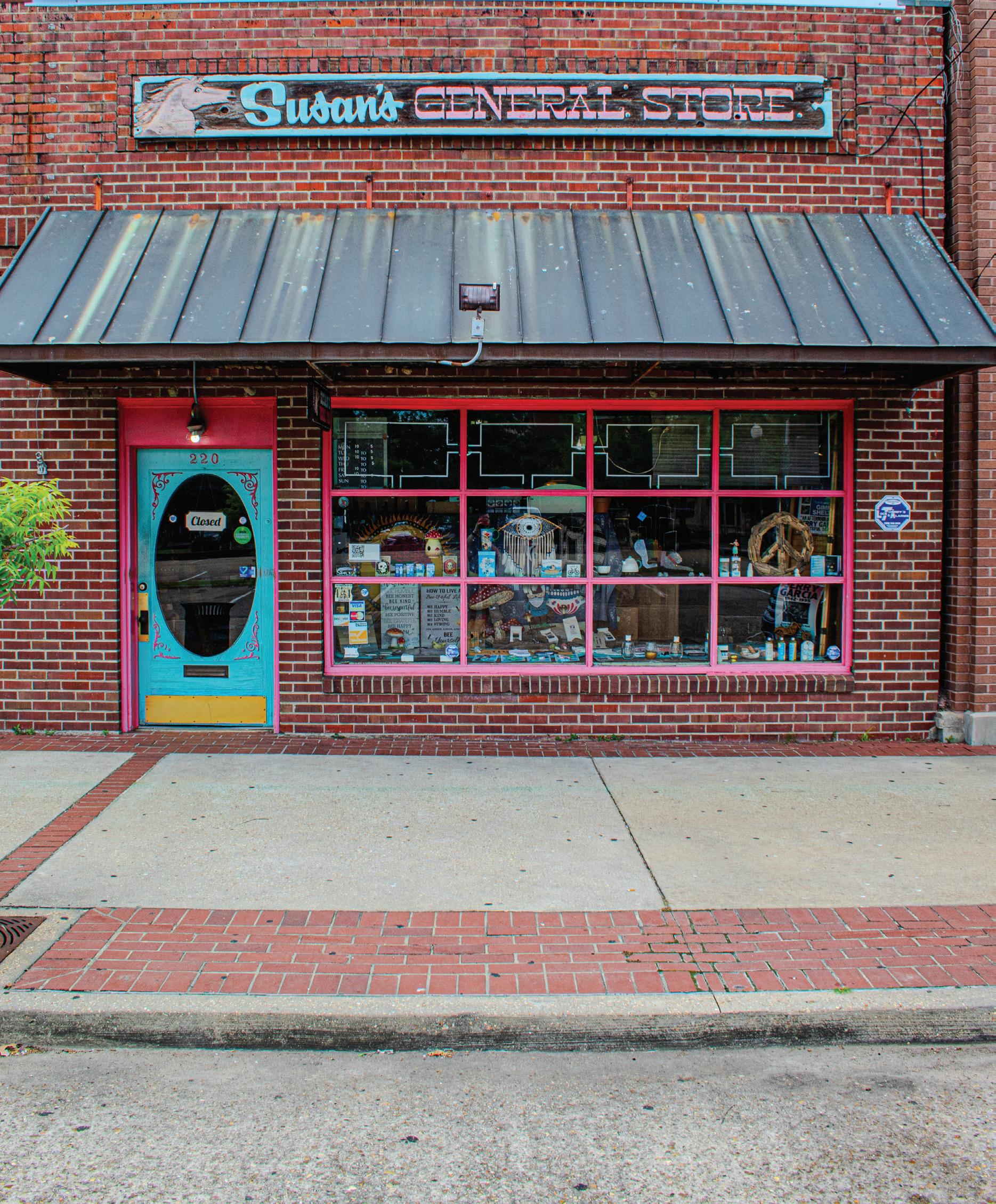
In Hammond, with its mix of residential and commercial architecture from the late 1800s and early 1900’s mixed with midcentury buildings, preservation is paramount. The city has done such a great job in fact, it won the Great American Main Street Award in 2022. Its picturesque historic Illinois Central Railroad train depot (a working Amtrak stop), plethora of boutiques and restaurants and verdant downtown gathering spots and greenspaces contribute to the best type of small town vibes.
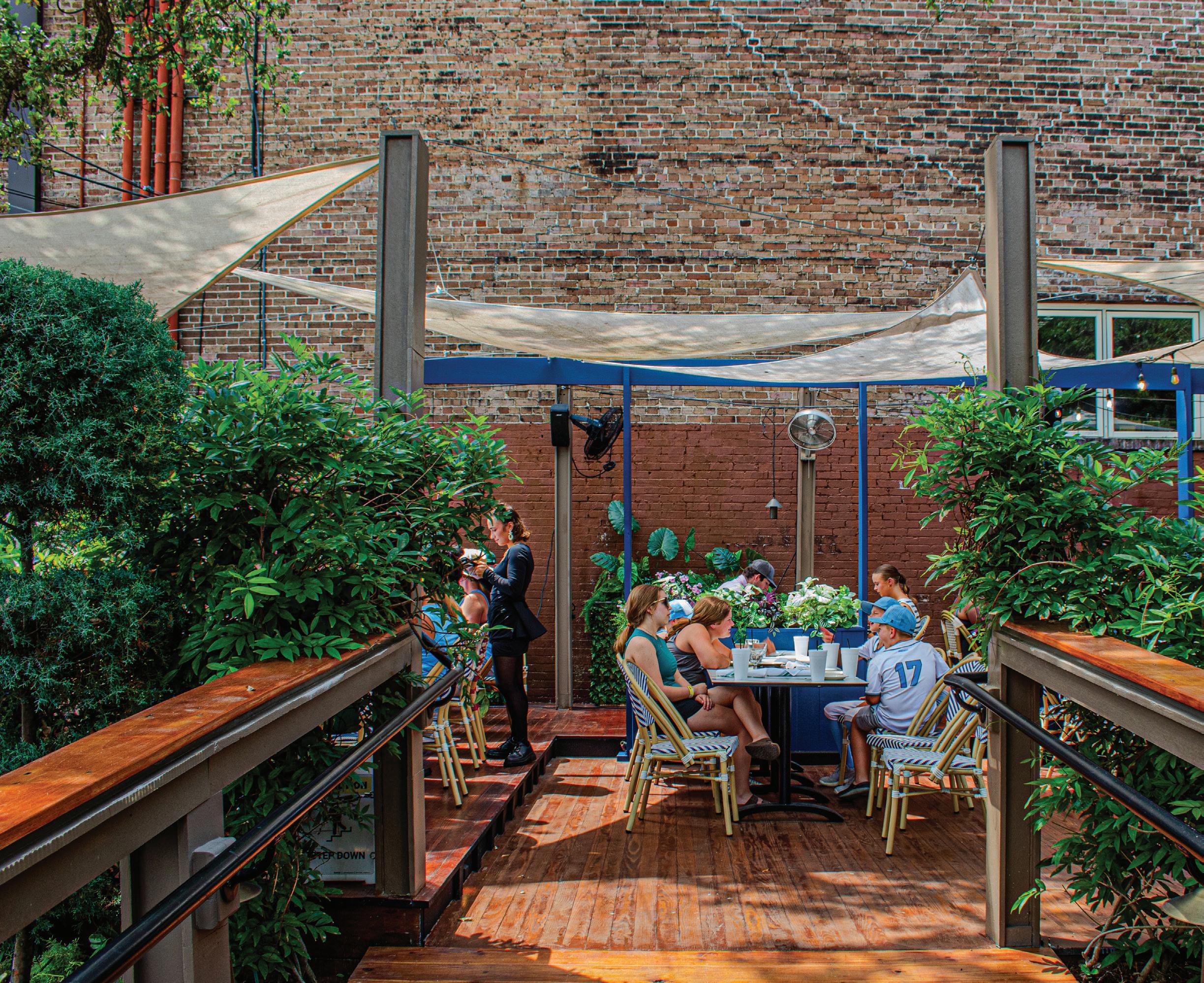
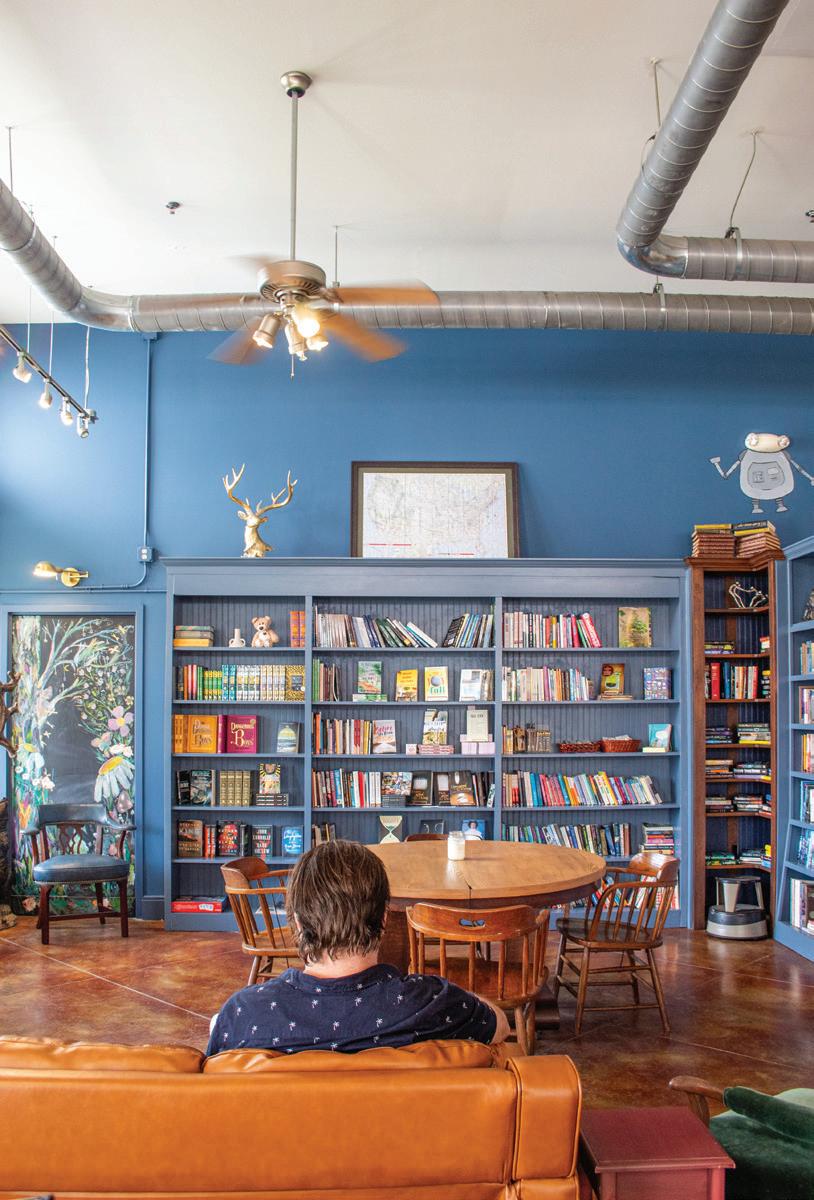
national fiction and nonfiction, as well as an incredible selection of gifts and a candy section specializing in nostalgic brands, such as Boston Baked Beans (candycoated peanuts). There are also a fair number of women’s clothing boutiques downtown, so while I was on a mission for books and music, it would be easy to wrap up your Christmas gift buying list and get an outfit for your holiday party in an afternoon downtown.
Having walked off my half cookie and lunch, I was considering a stop at Eddie’s Famous Frozen Custard, recommended by every person I talked to while on my shopping spree, but the parking lot was packed and the drive through line around the building. That would have to wait until another time, because I was due at the Historic Michabelle Inn. The grand, circa-1907 Greek Revival-meets-Queen Anne Michabelle Inn sports 14-foot ceilings and a central chimney that serves fireplaces upstairs and down, including the massive lobby hearth. French Chef Michel Marcais and his wife Isabel bought the home and opened it as an inn, which has been in operation since 1998. In 2011, the Marcaises

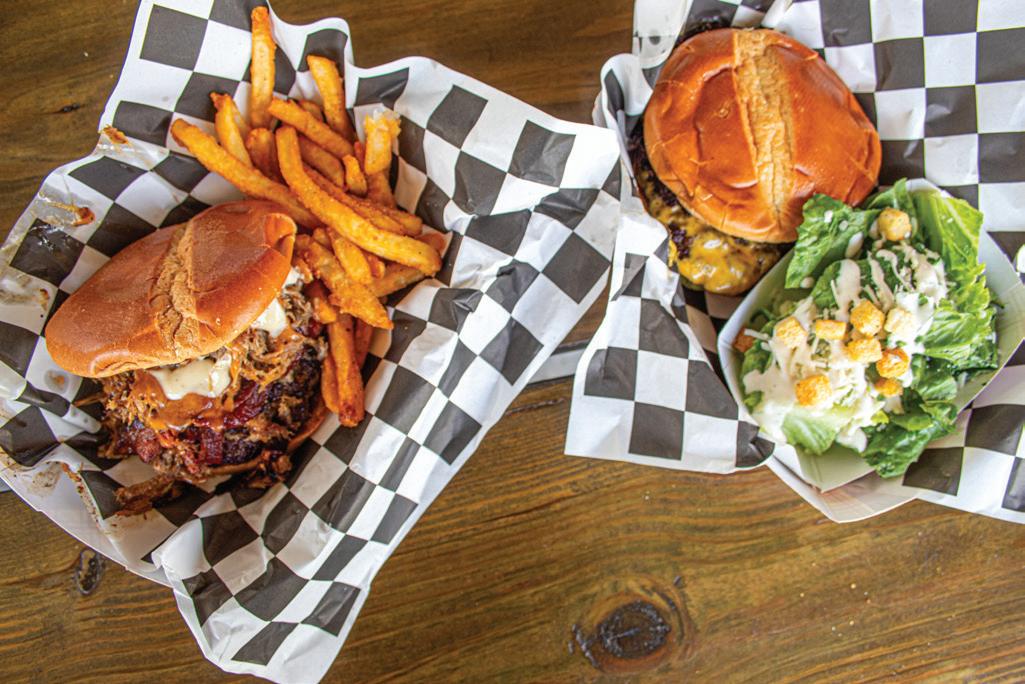
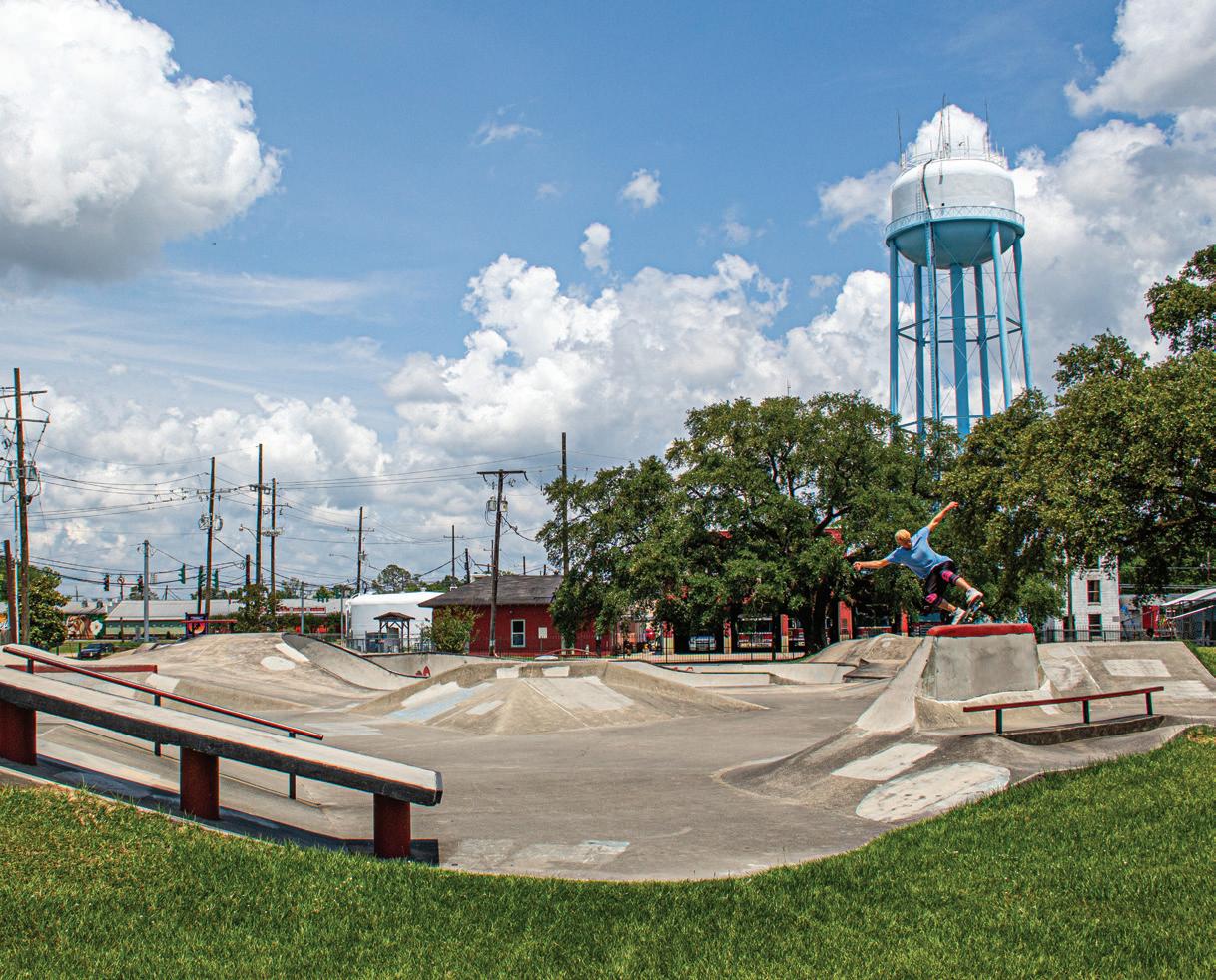
sold Michabelle to their daughter Sandra Bradley and her husband, David Bradley, who continue to expand the inn’s accommodations. In addition to the inn, Hammond also has various national chain hotels and VRBO options, but if you are an RV enthusiast, check out Deadbeat Brewing’s waterfront view accommodations via Harvest Hosts.
Craft beer lovers will have a ball at Deadbeat, as well as Gnarly Barley, which has racked up countless regional and national brewing awards. Back downtown, The Red White & Brew is both a carryout wine and beer store and a bar, so you can have a few brews and take some home, too.
As you can plainly see, my modus operandi in Hammond was sip, shop and eat, but there’s additional culture to consume if you visit. Parents will want to take the kids to the Louisiana Children’s Discovery Center, Zemurray Park (which has Dreamland Skate Park, a pool, walking trails and other attractions) and (not too far from downtown) the Safari Quest Family Fun Center with exotic animals and more. Work in
lots of nature at Joyce Wildlife Management Area (about 10 miles from downtown) and get your visual and performing arts fix at Hammond Regional Arts Center, the Columbia Theatre for the Performing Arts and Reimers Memorial Theater. Work the Tangipahoa African American Heritage Museum into your itinerary as well, for an enriching learning experience. Last but not least, a walk around Southeastern Louisiana University, depending on the weather, is also a worthwhile endeavor. Perhaps with an ice cream from Eddie’s if you have time to fight your way through the lines.
Like most of my jaunts to quaint towns and cities around the state, my tryst with Hammond was far too short. Each time I stop here, I find something else to add to my to-do list, or I regret not revisiting a fave from the last visit. This go around, I lament not returning to the Mariner’s Inn for a burger on the patio. As usual, I’m already plotting my return with hubby in tow for that burger and also, there’s this cute little historic cottage for sale, and he really must see it.
LOCATION
Hammond
1889 Hammond was chartered in 1889 and is named after Swedish immigrant and settler Peter Hammond.
13,861
Number of students at Southeastern Louisiana University for the 2025 spring semester. An historic high for the 100-year-old school.
22,527 As of the 2023 census, Hammond’s population is 22,527, making it the largest city in Tangipahoa Parish.
Scenic spots galore for fishing and hiking — great restaurants and wineries too
BY ELAINE WARNER
OKLAHOMA IS LIKE WONDERLAND: You won’t find it on a map. What you’ll find is an amorphous area encompassing the southeast corner of Oklahoma with Broken Bow Lake and Beavers Bend State Park as the catalysts for the region’s boom in popularity. Attractions are strung up and down U.S. 259 from Idabel to Hochatown.
The weekends are busiest and accommodations fill up well in advance. A new resort, Choctaw Landing Casino & Resort, is centrally situated and a great home base for a visit.
MORNING – Have breakfast at the Tuklo Grill at the resort, then head to Beavers Bend State Park. A tree-lined drive — U.S. 59, just north of the resort — will take you over Broken Bow Dam and past a swimming beach to the Forest Heritage Center where you can pick up park information. Take time to tour the museum to


learn history of the logging industry and see an impressive display of wood art.
A short hike on the Tree Trail will take you along the floodplain of Beaver Creek and back to your starting place near the Forest Heritage Center.
The Mountain Fork River below the dam is noted for its year-round fly fishing. If you’re a serious angler or want to learn, the Beavers Bend Fly Shop in the park provides great information and services.
Other park options include trail rides and a two-anda-half mile train ride on a one-third size replica of an 1863 C.P. Huntington train. Visit the Nature Center or try for an eagle on the park’s Cedar Creek Golf Course.
AFTERNOON – If you’re ready for lunch, Mountain Fork Brewery has great appetizers, salads, sandwiches and wood-fired pizza. Louisianians might want to try the boudin eggrolls. They’ll also offer you a taste of their beers — or order a flight.
To do your own wine tour, stop next door at Knotted Rope Winery, then head south to Girls Gone Wine, the


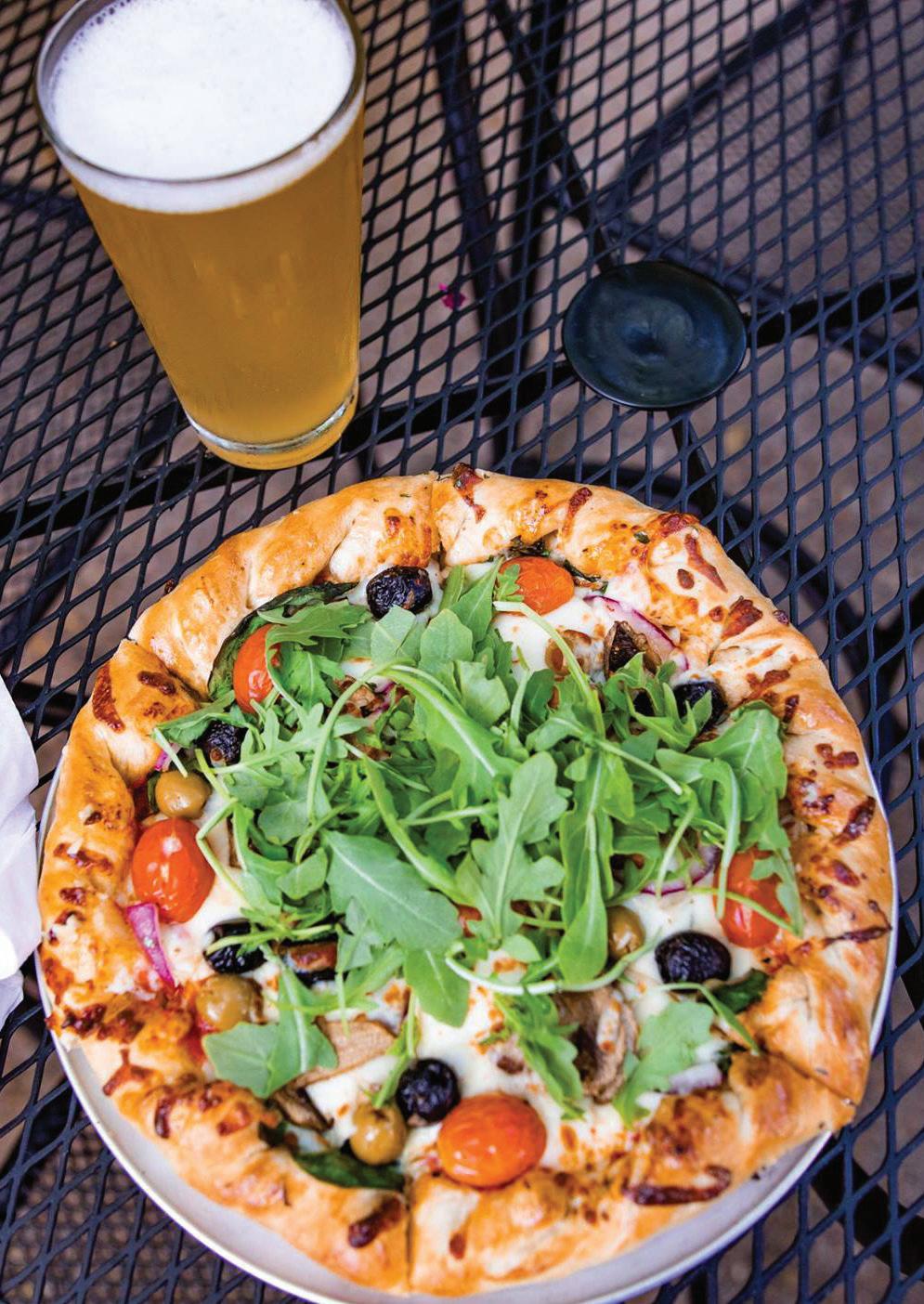
area’s oldest winery. While you’re there, check out their shopping areas full of unique gifts you didn’t know you needed. Fish Tales Winery & Bistro, farther south, specializes in wines made from local muscadine grapes.
EVENING – Grateful Head has a hippy vibe and great pizzas with hand-tossed crusts coated with house-made garlic butter. The brother-owners also have 20 beers on tap — soft drinks and sweet tea for the abstainers. Travelers with dogs enjoy the outdoor patio.
End the day in the Choctaw Landing Casino. This non-smoking facility offers 600 slots, several table games and a full bar.
MORNING – For breakfast, the fourth-generation, family-owned Stevens Gap Restaurant in Hochatown is a long-time favorite with locals. Fried catfish or chickenfried steak are big favorites for lunch and dinner.
Thirty minutes south in Idabel, you’ll find one of Oklahoma’s best museums, the Museum of the Red River (opens at 10, closed Mondays). The collections
include art and archaeology from around the world with an emphasis on indigenous cultures.
AFTERNOON – Papa Poblano’s in Broken Bow is noted for their great guacamole and more.
Get ready for some wet fun with a tubing trip with Lucky Dog River Floats. A serene one-and-a-half mile float will cool you off and relax you. A drier option would be an hour tour on Broken Bow Lake with The Broken Tiki. Enjoy the water and a little history on a pontoon party boat.
Area attractions include everything from mini golf, axe throwing, an escape room, a zip line and more — you won’t be bored.
EVENING – Abendigo’s is the perfect spot for a final dinner. Noted for their steaks, it’s the area’s most upscale eatery.
Back at the resort, check to see what’s happening on the Cypress Lawn — could be sports or movies on a big screen or live music on the weekend. Another weekend possibility — Hester’s Theatre of Magic.
Whatever your interest, whatever the weather, there’s always something to do in Beavers Bend.
To learn more, visitbeaversbendcabincountry.com.

BY DEEDEE MAHONY, HAMMOND

